Tajbibi Abualy Aziz (1926-2019) Part One
Essay
TAJBIBI ABUALY AZIZ
(1926–2019)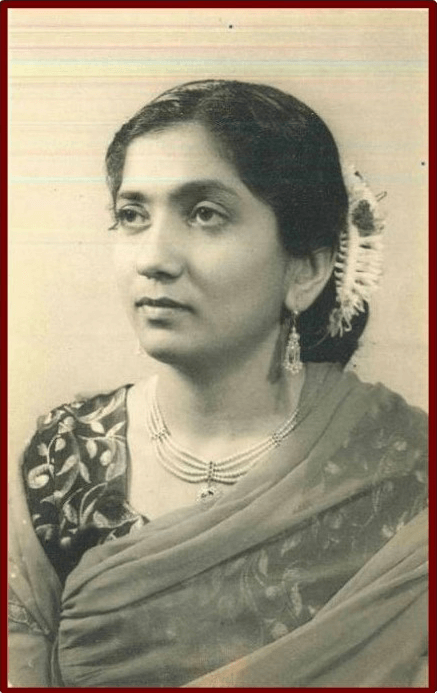
Part One
A Satpanthi SitaPreamble
TAJBIBI ABUALY AZIZ, my beloved mother, passed away on July 26, 2019. I present here a memorialization of her life in three parts, the first of which is presented below. The second and third parts (see the right sidebar) will be published in future issues of the Review.
Part One presents a photo essay of her life bookended by a Prologue and an Epilogue. The Prologue sets the frame of the essay by posing the question whether the kind of Satpanth faith that my mother grew up in and lived possesses any lessons or relevance for the young Ismaili women of the Jamats in Euro-American societies.1I prefer to use the term “Euro-American” in place of the conventional “Western” to reflect its civilizational, as opposed to its geographical connotation. Australia and New Zealand are not “Western” geographically—Queensland and New South Wales are located east of Japan—but they are appropriately “European” in their civilization. The Prologue is followed by the Photo Essay, which in turn is followed by the Epilogue. In the Epilogue I return to the question that I posed in the Prologue and offer some conclusions from my mother's life that the young women—especially college-educated young women—in the Euro-American Jamats may wish to reflect upon.
Part Two will focus on my mother's 20-year teaching experience at the Aga Khan schools in Dar es Salaam. Her teaching experience offers important, relevant and, in my view, very timely lessons for the Jamat's program for the training of religious education (RE) teachers.
Part Three will present a historically informed disquisition on the nature of the Satpanth Ismaili faith that my mother grew up in and lived to the end. It will identify distinctive features of this Satpanth faith that were at the core of her own faith and that also offer an instructive contrast with the other historical Ismaili traditions. These distinctive features of Satpanth—for example, the Ginans' relatively strong feminine character and the distinction between patriarchy and androcentrism that this “feminism” clarifies—present spiritual, intellectual and moral questions to our Jamat concerning the place and role of these features in the emerging Quranocentric conceptualization and practice of the Ismaili Tariqah.2In a future essay I will draw out and explain the distinction between the Ismaili Tariqah and the several Ismaili historical traditions.
Prologue
YOUNG ISMAILI WOMEN living in Euro-American societies are enjoying levels of achievements and degrees of freedom in all walks of life that were beyond the dreams of their mothers, grandmothers and great grandmothers.
They are highly educated and increasingly count among their ranks doctorates and international-caliber academics. They have built successful careers in academia, business and the professions; they have risen to senior executive and management positions in corporations and government; and they are now confidently seeking political careers to represent and serve fellow citizens in public office.
In their lifestyle, too, young Ismaili women enjoy freedoms that their mothers and grandmothers could not imagine. They are able to choose their partners, modes of relationship—including same-sex relationships—and sexual orientation (including transgender identity). They are free to live independently and, among other freedoms, to develop their own understanding and practice of the Ismaili Tariqah.
These unprecedented freedoms, and the achievements that these freedoms have brought them, are the fruits of the unrelenting feminism of Imams Sultan Mohamed Shah and Shah Karim. The lifelong tireless labors of Imam Sultan Mohamed Shah to advance the cause of his female followers, and that of Muslim women generally, are readily acknowledged today by the Jamat and by Ismaili women in particular.
My beloved mother, whose life I have distilled into the few photos below, generously and readily applauded these remarkable advances made by today's Ismaili girls and young women. But she could not avoid wondering whether she had anything in common with them other than the foundational principle, namely, that each Ismaili forges a personal and private link with the Imam. Nor could she avoid questioning whether her own life experiences and Satpanth faith had anything inspirational to offer these young women with their uncompromising and jealously guarded commitment to their autonomy and self-sufficiency.
For their part, the young women in the Jamat regard the life experiences of their mothers and grandmothers with a benign, if not altogether condescending, respect and tolerance. But very few of them are convinced that these “old school” women have any lessons to teach them on “how to be an Ismaili woman” in the modern Euro-American world. I suspect that they would find my beloved mother's life not just alien but irrelevant to their own lives and circumstances.
As I describe below in greater detail, my mother's life was marked to an exceptional degree by much abuse, suffering and hardship. Yet throughout she remained capable of showing compassion, generosity, self-sacrifice and dedication not just to her abusers, but also to the Jamat and the wider public. Nor did she let these abuses and hardships stand in the way of discharging her many duties—domestic, Jamati, professional and civic—with competence, diligence and dignity.
What was the source of this extraordinary capacity? It was her Satpanth faith.
Satpanth
The word "Satpanth" (True Path3The Sanskrit word panth and the English word path are Indo-European cognates of each other, just as the words ginān (Gujarati, Hindi), jnāna (Sanskrit), gnosis (Greek), kennen (German) and know (English) are Indo-European cognates of each other.) is rapidly becoming an alien and unrecognizable word by the younger generation of the Jamat in Euro-American countries. But for my mother, and for generations of men and women of the Jamats in India (and Africa), Satpanth was a religious tradition (dharam) that had fulfilled the promise of Vaishnavite Krishna-centric religion, namely, that there would come to them—our ancestors—the Tenth Avatār (Dasmo Avatār4The word avatār is a noun form of the Sanskrit word whose Gujarati cognate is utarvun, that is, “to descend” or “to come down.” In Part Three of my remembrance of my mother, I will have more to say on this idea of “descent” (of Lord Vishnu) in Hinduism and the Quran’s claim that it is a “descent” (nuzūl), or that it has “come down” (nāzil), from Allah. It is semantically misleading to translate avatār as “manifestation” or “incarnation.”) of Lord Vishnu, and that this Avatār would be the Nizari5The Pirs introduced the Nizari Ismaili understanding of Imam Ali to the ancestors of present-day Indian-origin Ismailis. This Nizari understanding of Imam Ali differs in some fundamental ways from that of the Fatimid, Dawr al-Satr and pre-Imam Ja‘far al-Ṣādiq understandings of Imam Ali, as it does from that of the post-Mustanṣir Musta‘lian Ismaili tradition. Imam Ali. Since Krishna and Ram were avatārs of Vishnu, the Pirs centered Satpanth (and the Ginans) on the Ali-Krishna and Ali-Ram identity: each of these three figures—Ali, Krishna and Ram—had a different biological body, cultural context and personality, but they all had the same Spirit/Nur in these different bodies.
The Pirs regarded the entire religious and cultural history of India as rooted in, and springing from, the same spiritual universe from which the Abrahamic and Quranic religious landscape sprang forth. Both religious traditions—Vedic and Abrahamic—were different worldly religious and cultural forms of the same spiritual universe. With this fundamental understanding of the same spiritual source of the two formally different and superficially incompatible religious traditions, the Pirs were free to reach back to the primordial origin events of Vedic religion and recognize the religious personalities, beliefs and practices—cosmologies, eschatologies, doctrines, rituals, mythologies, and so on—as expressing the same spiritual realities that the Abrahamic and Quranic religions expressed.
The Pirs' spiritualist conception of Indian religious history is part of Prophet Muhammad's spiritualist conception of human history, namely, that if one steps below the surface of human social history, one discovers that there is only one spiritual world—one spiritual continuum—below the religious and cultural diversity of humanity. None other than Imam Sultan Mohamed Shah articulated this insight in the following succinct words:
Mohamed…by admitting that no people, race or nation had been left without some kind of divine illumination, gave his Faith universality in the past, and in fact, made it co-existent with human history.
The Pirs brought this insight of Prophet Muhammad to the Indian component of human history and taught it to our Satpanth ancestors. This spiritualist conception of human history—of humanity's religious and cultural diversity—as expressed by Imam Sultan Mohamed Shah, is not susceptible of academic approaches because the academic disciplines rest on tacit materialist secular-humanist principles that deny the spiritual world any agency in the dynamics of history and human social evolution. They therefore confine themselves to the study of forms, and they admit of no other causality than that obtaining among forms.6By "forms" I refer to the respective subject matters of the disciplines in the humanities, social sciences and the natural (physical and biological) sciences, and to the several applied and practical disciplines that rest upon these three basic components of the World of Learning. One very influential approach today to the study of religion is anthropologist Clifford Geertz’s notion of religion as a “cultural system,” a notion that has, derivatively, spawned the study of religion as a “cultural expression” that is then subject to the forces (forms) of history—that is, to political, economic, military, legal, social, intellectual and other forms.
This, in a nutshell, is the foundational insight that guided the Pirs gyroscopically through the otherwise bewildering thicket of Indian religions, mythologies and intellectual traditions and enabled them to engender the fusion7I object to such words as "syncretism" and "synthesis" for how Satpanth brought (or put) together Nizari Ismaili Islam and Hinduism. I will elaborate on this objection in Part III of my remembrance of my mother. of Nizari Ismaili Tariqah and Vedic religion into Satpanth.
Today, the Jamat is undergoing a historic and fateful reconceptualization of the Ismaili Tariqah whose long-term consequences cannot be discerned with clarity or certainty. The core of this reconceptualization consists in making the Quran the sole de jure and de facto supreme Scripture for all historical and future (new) Ismaili traditions. The primary motivation for this reconceptualization seems to be the (pressing) need felt by the institutional leadership to anchor the Islamic bona fides of the legitimacy of the Ismaili Imam's religious and spiritual authority in the one and only source that is recognized by the Ummah as the supreme authority over all Muslims: the Quran.
This perceived need has arisen because there are two Ismaili historical traditions8By "Ismaili historical traditions" I mean, firstly, the several Nizari Ismaili traditions (as distinguished from the Musta‘lī traditions) and, secondly, those Nizari traditions that have continued to recognize Imam Sultan Mohamed Shah and Shah Karim as their Imam. From a strictly historical and phenomenological perspective, the Imam Shahis and present-day Khoja Sunni and Khoja Ithnashari (Ithnā ‘Asharī) communities are of Nizari Ismaili provenance, even though they disavow Imams Sultan Mohamed Shah and Shah Karim as their Imam. I do not include them in the expression “Ismaili historical traditions” in this essay.—as of our present state of knowledge—in which the Quran has not, historically, enjoyed de facto supreme scriptural authority.9This and the next few paragraphs offer what I describe as phenomenological distillations of trends in the Jamat that I have observed over the past few decades. I hope to offer a fuller elaboration of these remarks in a future article. The first of these is Satpanth, in which the Vedas and their derivative and subsidiary traditions—spiritual (Vaishnavite bhakti), legal (dharma as defined by Manu's Laws10The older and native title for Manu’s text is Mānavdharmashāstra, whereas the colonial-era title that became popular in Europe is Manusmrti.) and mythological (Mahābhārata, Rāmāyana, Purānas, etc.)—enjoyed de facto supreme scriptural authority. All these traditions were seamlessly fused together into the Ginans by the spiritually inspired creative genius of the Pirs. The Ginans thus became and remained, until the contemporary project to reconceptualize and reformulate the Ismaili Tariqah, the de facto supreme scripture for Satpanth Ismailis.11It is therefore incorrect to describe or label the Ginans as "religious poetry" or "sacred lyrics," just as it is incorrect to describe or label the Quran as "religious poetry" or "sacred lyrics" (the Quran vehemently denies that it is poetry). The Ginans are the scripture (shāstra) of Satpanth in the same way as the Quran is the scripture of Islam. The Quran is the de jure as well as de facto scripture of Islam. In the case of Satpanth, however, the Quran is the de jure scripture but the Ginans are the de facto scripture. What counts in practice is the de facto scripture.
The second Ismaili historical tradition in which the Quran has not served as the de facto supreme scripture is that of the Pamir-Himalayan Ismaili tradition that traces its founding to the great Iranian Ismaili scholar, poet and dā‘ī, Nāṣir Khusrav (henceforth, Nasir Khusraw, d. 1088). Just as the Ginans were the de facto supreme scripture for the Satpanth Ismailis, so were Nasir Khusraw's poetry and expository doctrinal writings the de facto supreme scripture for the Pamir-Himalayan Ismailis.12We owe our current state of knowledge of this Ismaili tradition to the American anthropologist Jonah Steinberg's ethnographic study, Isma‘ili Modern: Globalization and Identity in a Muslim Community (2011). I will offer an in-depth discussion of this book in a future book review article.
Thus the impact of the contemporary trend toward an exclusively Quranocentric reconceptualization of the Ismaili Tariqah is most fateful for these two traditions. In the case of Satpanth, all Krishna-centric (and, ultimately, Vedic) content and references in Satpanth beliefs and practices have been, and are in the process of being, replaced with exclusively Quranocentric names, connotations and references.
For example, the Vedic-rooted vocabulary for spiritual master or guide (swāmi, nāth, guru, sāṅhīāṅ, deval, bālam, morāri, etc.) has now come to refer exclusively to Imam Ali and the succeeding Imams leading up to Shah Karim. Among the important shifts to Quranocentric practices I may mention the following: the term mandli has been replaced by the term majlis; Navmi Rāt mandli has been renamed Pānch Bār Sāl Majlis; Satī Mā Jo Rojo has been renamed Mowlā Jo Rojo; and so on. These are “as is” phenomenological observations on my part; I make no evaluative judgments on these changes since they are not germane to what I have to say about my mother below.13I will present a fuller treatment of the impact of this reconceptualization on Satpanth in Part Three of my remembrance of my mother.
Mahābhārata and Rāmāyana
There is one extremely important casualty of this reconceptualization of the Ismaili Tariqah: the two great epics of Indian religion and culture, Mahābhārata and Rāmāyana, are excluded from it. Both epics are part of the historical Satpanth tradition. The central male divine figure in Mahābhārata is Krishna, whereas the central male divine figure in Rāmāyana is Ram. The Pirs reconceptualized these epics as the life stories of Imam Ali by spiritually recognizing Krishna and Ram as Ali—and, conversely, spiritually recognizing Ali as Krishna and Ram. The Pirs then included in their Ginans stories from these two epics because, to them, they were stories involving Ali.
For Tajbibi, my mother, these epics were an integral component of her Satpanth dharam. In particular, two archetypical female personalities in these epics were destined to become very influential in her life: Draupadi in the Mahābhārata, and Sita in the Rāmāyana.
Draupadi in Mahābhārata
Draupadi has represented, for Indian women through the centuries, deliverance from suffering, abuse, humiliation, and the crushing of the spirit. In the Mahābhārata, she pays the penalty when her easily-duped Pāndava husbands lose the dice game against the cunning Kauravas. The penalty is that she should be disrobed in front of the assembly. Panic-stricken at the thought of being stripped naked, she cries out to Krishna to preserve her honor (lajā in the Ginan by Pir Abdul Nabi). Krishna is not present physically but hears her cries (venti) spiritually, and instantly comes to her rescue.14As Dushasan pulls at her sari to disrobe her, Krishna replenishes the sari by the exact length that has been pulled, with the result that Draupadi remains fully clothed all the time. Dushasan carries on pulling at the sari but eventually becomes tired and gives up.
Sita in Rāmāyana
Sita, on the other hand, teaches Indian women how to suffer. She is the archetype in Indian culture of the dedicated, self-sacrificing and silently suffering wife whose husband and in-laws (sasurāl) subject her to one form of cruelty upon another. Sita patiently and silently bears this suffering while remaining compassionate, generous and altruistic toward others who come to her for help.
My mother instinctively experienced her oppression at the hands of her merciless in-laws as Sita's oppression at the hands of her in-laws, and she instinctively responded to her oppressive situation by drawing on the example Sita had set for her Indian sisters.
Through all her different types of responsibilities—wife, mother, daughter-in-law, sister-in-law, breastfeeding volunteer at the Diamond Jubilee (1946), administrative aide at the Ismaili Mission Centre, sister and mother to Mission Centre students, teacher, founder/general-secretary of a civic organization, sister and mother to upcountry boarders (boys and girls), Jamati volunteer, library committee member, "support staff" to a scholar-preacher husband, travel companion, host to daily visitors, and so on—Tajbibi unimpeachably lived up to the ideals set for her by Sita: to suffer in silence yet be compassionate, generous, kind, and always accessible to those who came to her for help.
My mother often said to me, in a pained and resigned tone, Kaun sunegā meri kahāni? [Who will hear my story?] Would she have asked this question had she believed that the young women in the Jamat looked to her life experiences and Satpanth faith as sources of inspiration for their own lives as Ismaili women in the modern era?
Later in this essay, in the concluding Epilogue, I will return to this question.
Photo Essay
Tajbibi Muradali Juma was born in Mumbai on July 4, 1926. Her mother, Rehmat, was from Zanzibar. Her father, Mohamed Muradali Juma, was a senior missionary in the Mumbai Jamat. His family had remained loyal to Imam Aga Hasanali Shah during and after the famous Khoja Case (Aga Khan Case15The historic Khoja Case had vindicated the claim of Imam Aga Hasanali Shah that he was the latter-day Tenth Avatār (Dashmo Avatār) that the Pirs had presented to the ancestors of the Khoja. This claim was the basis of his claim that he was, therefore, the rightful legitimate spiritual leader, the Naklanki, of the Khoja community. Contemporary scholars of the Khoja Case now refer to it as the Aga Khan Case, the title of Tina Purohit’s 2011 book. I will discuss this book in a future review.) in the 1860s.
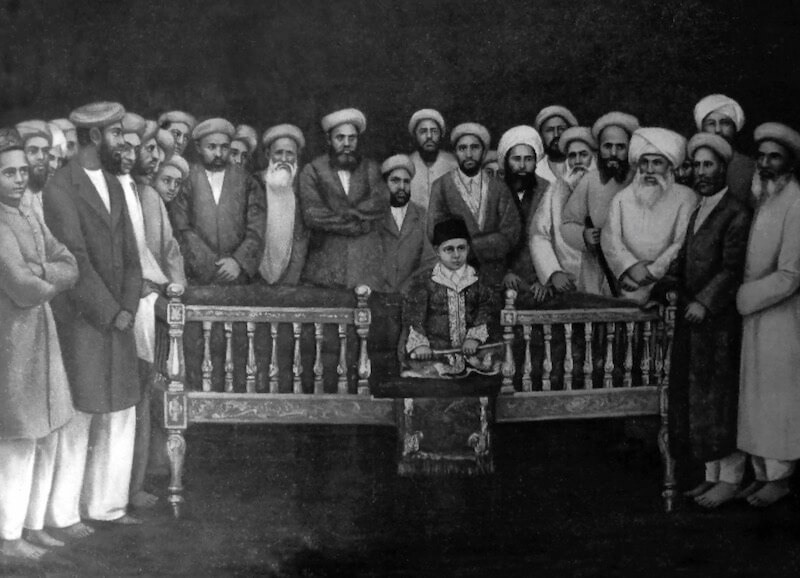
Photo 1
This famous photo was taken in Mumbai within days after Imam Sultan Mohamed Shah became Imam in 1885. He is surrounded by Jamati leaders, among whom was Tajbibi's grandfather, Muradali Juma. He is standing seventh from the right, face partially obscured, with only the right side of his moustache and beard visible. Courtesy Yasmin Karim.
Tajbibi's grandfather, Muradali, used to accompany his father Juma on Imam Aga Hasanali Shah's hunting expeditions. One day the young Muradali picked up the Imam's hunting rifle and accidently triggered the gun, which blew away the top half of all his fingers on his right hand.
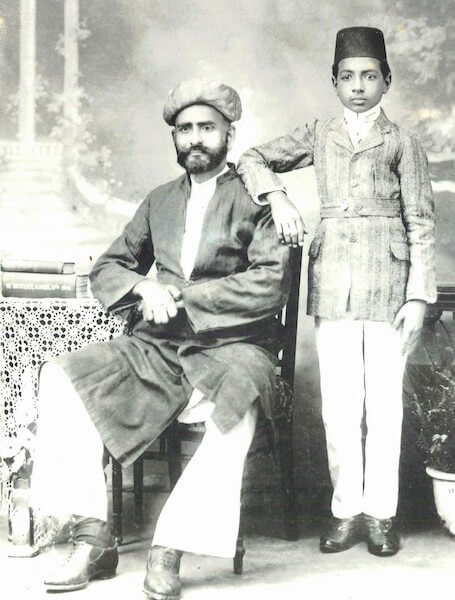
Photo 2
Muradali Juma with his son Mohamed (Tajbibi's father). All the fingers of his right hand are missing their top half. Abualy Collection.
Missionary Mohamed Muradali used to travel to other Jamats to deliver waezes (sermons). He also carried out mission work (da‛wa) among the Untouchables. Over the years, Missionary Mohamed and Rehmatbai ended up adopting five orphans, three of them Untouchables.
Tajbibi's mother, Rehmatbai, was a simple unschooled woman. But she had a heart of gold and was a driving force in the decisions regarding adoptions. Nothing illustrates clearly her astonishing compassion than the story concerning one of her adopted children, whom they named Sadru.
Missionary and Rehmatbai Muradali were walking along a Mumbai street one day when they spotted an infant boy lying on the sidewalk. He had been abandoned and was naked and lying on the ground in his own excreta. Rehmatbai stopped and told her husband that she had decided to adopt the little boy. The [now-deceased] Sadru became Tajbibi's adoptive brother. Rehmatbai would add to the household by adopting another boy a few years later.
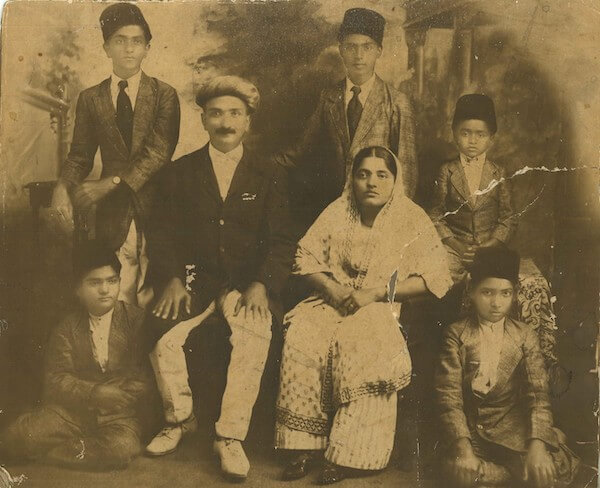
Photo 3
This family photo was taken before Tajbibi was born: Missionary Mohamed Muradali with his wife Rehmat and their three sons and two adoptive sons. Ramzan, the eldest son, is standing to the left. Standing behind Rehmatbai is the elder adoptive son, and the small boy standing to her left, behind her, is Shams, the youngest son. Seated by the feet of Mohamed Muradali is Jaffer, the second son. Seated to Rehmatbai's left is the adopted Kaderali Patel, who grew up to be a missionary and was appointed religion teacher to Princes Shah Karim and Amyn Mohamed by Imam Sultan Mohamed Shah. Abualy Collection.

Photo 4
Tajbibi's parents: Missionary Mohamed Muradali Juma and Rehmatbai Muradali Juma. Ca 1960s. Courtesy Yasmin Muradi.
Missionary Kaderali Patel
One of the Untouchable adopted boys was Kaderali Patel. This young boy would accompany Missionary Mohamed on his waez tours and was inspired to become a missionary himself. Missionary Mohamed trained the young Kaderali to become a preacher. Imam Sultan Mohamed Shah subsequently instructed the young missionary to go to East Africa.
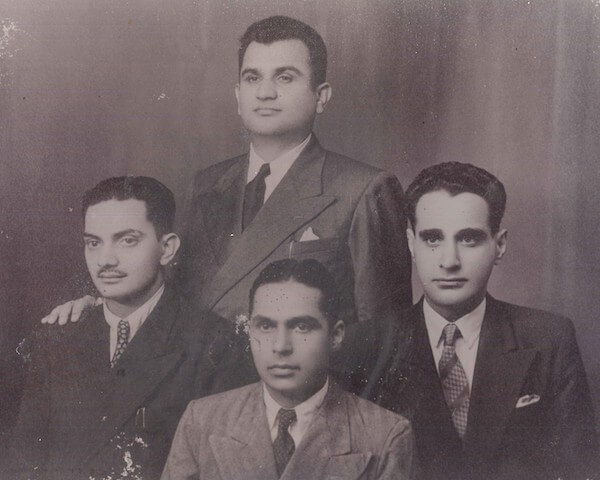
Photo 5
This photo, taken in the late 1940s or early 1950s, shows Missionary Kaderali Patel (seated, center) with fellow missionaries Gulamhussein Juma (standing), Abualy Alibhai Aziz (seated, left) and Amirali Khudabux Talib (grandfather of Malik Talib, former President of the Aga Khan Council for Canada). The Talib family has a long distinguished record of multigenerational devoted service to the Imam and Jamat. Abualy Collection.
Later, Imam Sultan Mohamed Shah appointed , Tajbibi's adoptive brother, as religion instructor for his young grandsons Prince Karim (the present Aga Khan IV) and Prince Amyn Mohamed. The young princes were living in Nairobi during World War II. Missionary Patel traveled to Nairobi to discharge his duties.
Academic Award at School
Tajbibi attended the Ismaili community's primary school in Dongri. She remembered it as a three-floor building. This building is most likely the building housing the Diamond Jubilee Girls' High School today, which took over from the primary school in 1947 (the building itself was built in 1925).16I want to thank Shamim Suryavanshi of Mumbai for her generosity in expending time, thought and labor to research the history of this school building on my behalf.
In those days, schooling ended at the 7th grade. Upon matriculation, Tajbibi received an English novel, Black Beauty, in recognition of her academic excellence. In this remarkable novel, written in 1877, the English author Anna Sewell looks at human society through the eyes and experiences of a horse. The horse complains about all sorts of cruelties that humans inflict on horses. Sewell became an advocate for the humane treatment of animals. Black Beauty has become to the animal rights movement today what Mary Wollstonecraft's A Vindication of the Rights of Woman (1792) is to the feminist movement.17Was Sewell familiar with the story in the Rasā’il of Ikhwān al-Safā’ in which the animals complain to the king about human cruelties against them? Research into this question would make for an ideal BA honors or an MA thesis.
Girl Guide
Tajbibi was a Girl Guide in the Dongri Jamat. In 1935, to mark the occasion of Imam Sultan Mohamed Shah's Golden Jubilee, the Imam posed for a photo with the Ladies Volunteer Corps and Girl Guides of the Mumbai Jamat.
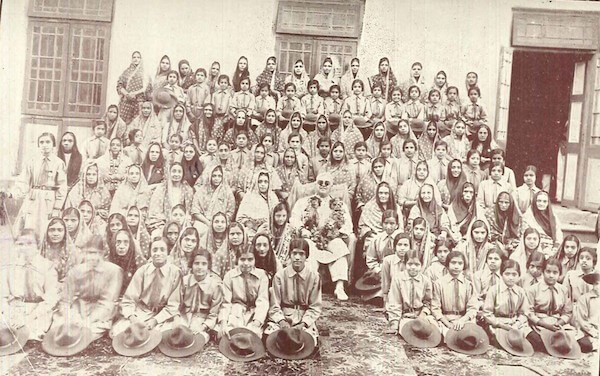
Photo 6
Tajbibi was a 9-year-old Girl Guide (seated on the floor in the front row, third from the left in the right half of the row). Her mother, Rehmatbai, was a volunteer. She is standing in the row behind the Imam's row, fourth from the right. [Photo from Position of Woman Under Islam, by Syed M. H. Zahid Ali, 1935. Foreword by Imam Sultan Mohamed Shah. Abualy Collection.]
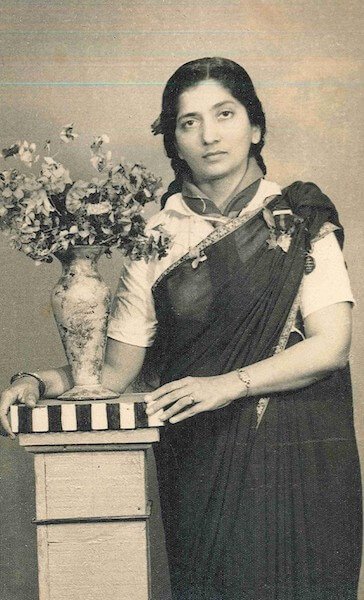
Photo 7
Tajbibi as captain of the Girl Guides of the Dongri Jamat. Early 1940s. Abualy Collection.
Missionary Mohamed Muradali and the Recreation Cub Institute
Tajbibi's father, Missionary Mohamed Muradali Juma, went on to become one of the most respected and revered missionaries in the Indian Jamat. He was a senior member of the Recreation Club Institute that Imam Sultan Mohamed Shah had formally inaugurated in 1923 as a multipurpose institution engaged in religious, social and economic activities.18For a very valuable entry point into the origins and activities of the Recreation Club Institute, see the article “Recreation Club Institute” in Encyclopedia of Ismailism by Mumtaz Ali Tajddin Sadik Ali. This article is also accessible at http://www.ismaili.net/heritage/node/10467. Mumtaz Ali Tajddin Sadik Ali is an unsung and unappreciated hero of the Jamat. He has devoted his entire life singlehandedly publishing an astonishing number of books on the Ismaili Tariqah. The Recreation Club Institute is crying out for a doctoral dissertation by some enterprising young Ismaili scholar. The Institute served as a mutual support center for the missionaries, who sought advice and knowledge about Satpanth, Ginans and the Ismaili Tariqah from each other.
Among the notable colleagues and friends of Missionary Mohamed were missionaries Khudabux Talib (great grandfather of Malik Talib, former president of the National Council for Canada), Alidina Asani (grandfather of Professor Ali Asani of Harvard University), and Chief Missionary Husseini Pirmohamed Asani (step-brother of Alidina Asani).19Thanks to Professor Asani and President Talib for providing helpful details about their respective relatives.
Following the passing of Missionary Mohamed Muradali in 1965, the Imam sent a letter of condolence and blessings for the late missionary and his family (below). The Imam described Missionary Mohamed Muradali as a "candle of light."
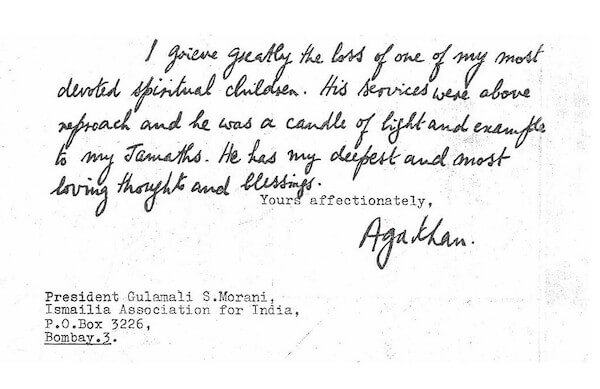
Photo 8
In his February 14, 1966 letter of condolence and blessings on the passing of Missionary Mohamed Muradali, Mowlana Hazar Imam added the above handwritten special message below the typed text of the letter (which is not reproduced here). Abualy Collection.
Tajbibi Marries Alwaez Abualy
Alwaez Abualy had come south from Amritsar to Mumbai to study at St Xavier College (University of Mumbai). The young Urdu-speaking Punjabi met Tajbibi at the Recreation Club Institute, where she had gone with her father, Missionary Mohamed Muradali. They were married on June 27, 1943.
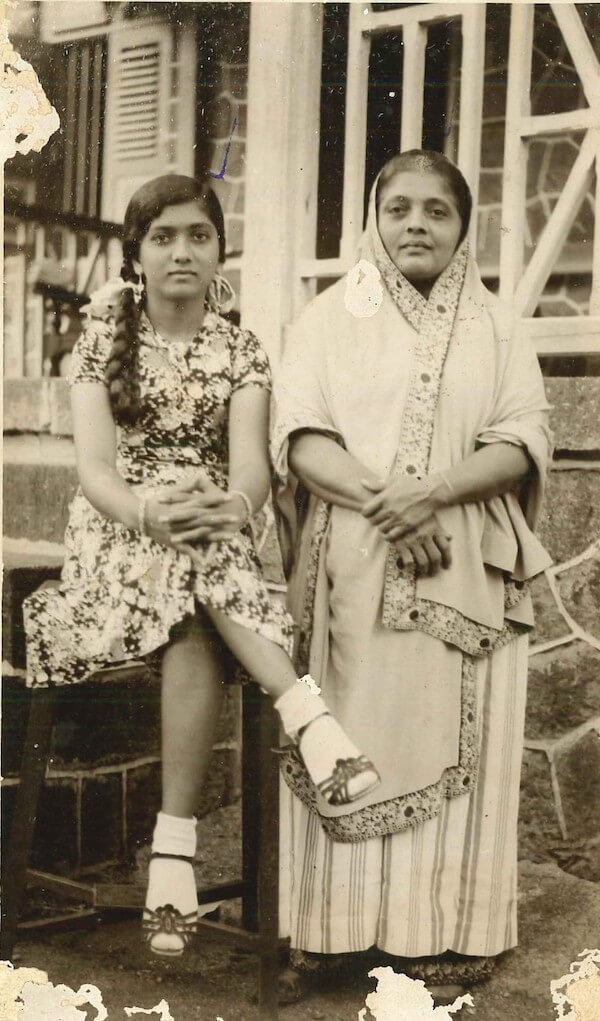
Photo 9
Tajbibi was 16 when she posed with her mother for this photo. She would be married to Alwaez Abualy the following year. Abualy Collection.
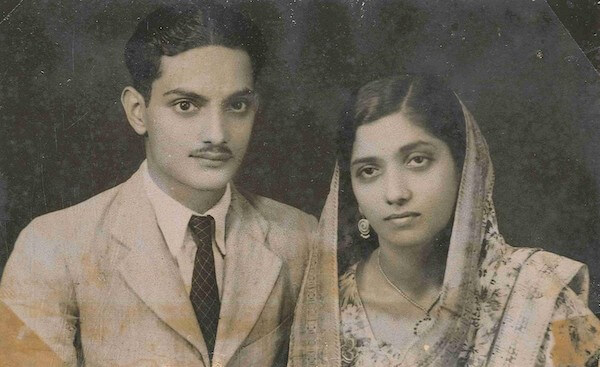
Photo 10
This photo of Tajbibi and Missionary Abualy was taken on July 4, 1943, Tajbibi's 17th birthday, one week after their wedding in Mumbai on June 27, 1943. Abualy Collection.
Foretaste of Abuses to Come for Tajbibi
A life-changing humiliating, traumatizing and degrading shock awaited Tajbibi as she arrived at her in-laws' home in Amritsar. Her mother-in-law, who had wanted her son to marry the Punjabi girl she had chosen for him, prohibited Tajbibi from using the family toilet. She was forced to use the servant's toilet. In a flash, Tajbibi's world turned upside down. Amritsar remained an unhealed gash in her soul for the rest of her life.
Tajbibi was the youngest child and only daughter in her family. Her brothers were very loving, caring, and protective of her. They were her eager servants ready to do whatever she wanted. She was their rāni (princess). She was also blessed with sisterly bonds with the girls in the five-floor building (Shariff Mansion) that her family lived in. One of the families in the building was a Jewish family. They were known affectionately in the neighborhood as Bani Israel. Their daughter Rachel and Tajbibi were the closest of friends, and they played and spent time together. Tajbibi was a much-loved popular and respected girl in the Dongri Jamat, in which she had been appointed captain of the Girl Guides. The school was another nurturing community of girls and teachers that Tajbibi grew up in. Girls and boys treated her as their sister, and adults regarded her as their daughter.
Nothing in this Mumbai background had prepared her for the catastrophe that ambushed her—an innocent seventeen-year old girl—as she arrived with her Punjabi husband at her in-laws' residence in Amritsar.
Worse was to follow, as I describe later, below.
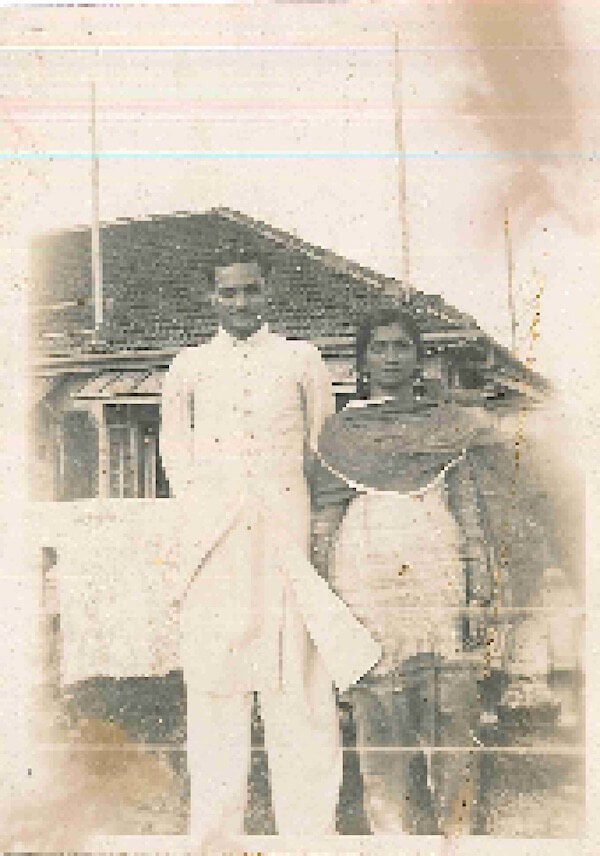
Photo 11
Tajbibi and Alwaez Abualy soon after their wedding in Mumbai in June, 1943. Abualy Collection.
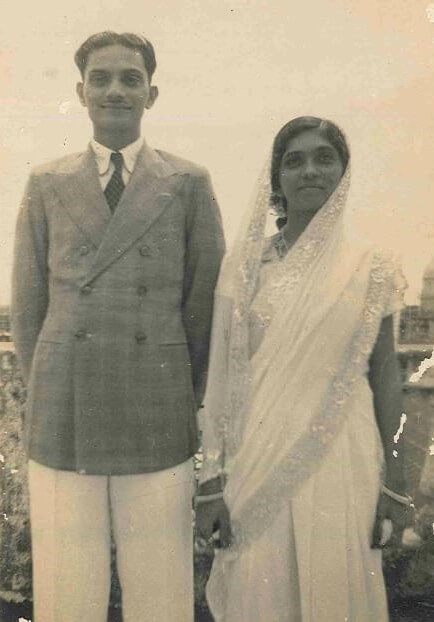
Photo 12
Tajbibi and Alwaez Abualy before their migration to Africa, ca. 1943-45. Abualy Collection.
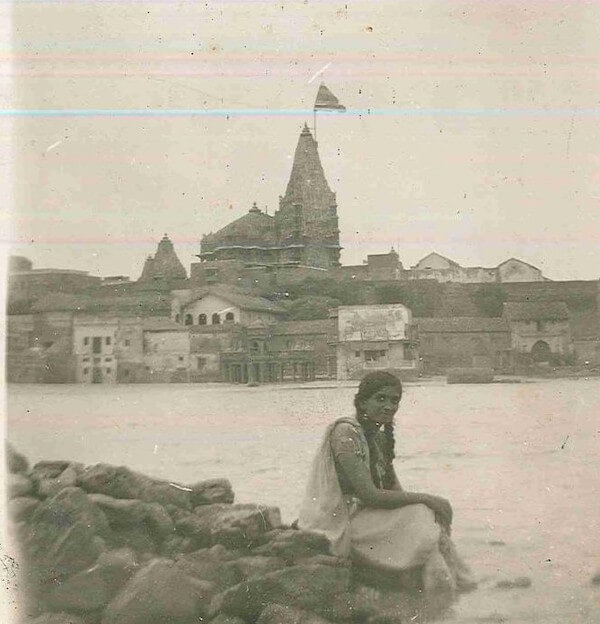
Photo 13
She wrote on the back of the photo: "We, my brother Jaffer and a friend Sadrubhai were travelling to Karachi when we had a stop over at a Holy Place Dwarka. I am expecting with Mohamed." The temple in the background is Dwarkhadhish Temple.20Dwarka is mentioned in the Mahābhārata. According to Hindu legend, Dwarka was the site where Krishna built his palace. The temple itself was built on Krishna’s palace by his grandson Vajranbh. Childless and pregnant women visit the temple to seek Krishna’s blessings. My mother was well aware of this role of the temple when she visited it. one of the four ancient temples in the city, which is located in northwestern Gujarat. Abualy Collection.
Migration to Africa
Soon after arriving in Mumbai to study at the University of Mumbai, the 20-year old young Punjabi Alwaez joined the Waezeen group and began delivering waezes (sermons). The Kutchi and Gujarati-speaking Mumbai Jamat had not seen or heard anyone like him before. His powerful Urdu sermons (waezes) took the Jamats by storm. He had become a sensation.
Already several years back in Amritsar, Imam Sultan Mohamed Shah, on one of his visits to the Jamats in Punjab, had recognized in the young 14-year-old boy the makings of an Alwaez. He ordered—hukm, as my father would proudly tell me—the young boy to become a missionary: Abualy, tum missionary bano ("Abualy, you become a missionary."). For his Mumbai visits, the Imam also appointed him as the transcriber of his Farmans and asked him to accompany him to the various Jamats in the greater Mumbai area. The Imam delivered Farmans in Urdu, which was Alwaez's native language (alongside Punjabi).
A fateful moment for Tajbibi arrived when Imam Sultan Mohamed Shah appointed Alwaez Abualy as director and lecturer of the newly created Ismailia Mission Centre in Dar es Salaam, Tanganyika (Tanzania) to train home-grown Waezeen.
Africa had become something like a Promised Land for the numerous communities on the west coast of India (Goans, Sikhs, Memons, Hindus, Muslims, others). There had developed within each of these communities a "scramble for Africa," an organized movement to send young men and women to Africa where they would settle and transplant the religious and social institutions of their respective faiths.
For Tajbibi, Africa represented a mixed blessing. On the one hand, she did not want to sever her ties with her parents and siblings. On the other hand, she welcomed the prospect of escaping from the abuses of her in-laws. The Imam's appointment of Alwaez Abualy was fateful for Tajbibi because she did not have the faintest clue as to what the future life in Africa had in store for her.
Tajbibi, Alwaez Abualy and I—six months old, for I was born in December 1945 in Mumbai—sailed for Dar es Salaam in July 1946, arriving there just in time for the Imam's Diamond Jubilee celebrations in August.
Suckling Babies at the Diamond Jubilee of Imam Sultan Mohamed Shah
The very first major event in which Tajbibi volunteered immediately upon arriving in Dar es Salaam was the Diamond Jubilee of Imam Sultan Mohamed Shah in August 1946.
A most remarkable act of volunteerism during the Diamond Jubilee celebrations was the suckling of babies and infants by volunteer young mothers in the Dar es Salaam Jamat.
Ismailis arrived in Dar es Salaam from all parts of Africa, including South Africa. They were hosted by members of the Dar es Salaam Jamat. Among the guests were young mothers with suckling infants. In order to give these women the opportunity to take part in the many programs marking the historic event, young mothers in the Dar es Salaam Jamat volunteered to suckle the babies of their guest sisters. Tajbibi Abualy was one such volunteer who breast-fed several babies over the course of the celebrations.
I invite young women in the Euro-American Jamats to reflect on the enormity of this act of sacrifice by these women on behalf of their sisters-in-faith. Most of today's young women in the Jamat are likely to use the bottle to feed their babies (if and when they become mothers). What sort of sisterly bonds (dīn baheno) made such sacrifices not just a possibility but a no-brainer for my mother when today it would cause our young women to shrink in horror?
The Ismaili Mission Centre
As the wife of the director of the Ismaili Mission Centre, the 20-year-old Tajbibi found herself thrust into a range of administrative and social duties for which she had not been prepared but which she accepted and discharged with skill, grace, and compassion.
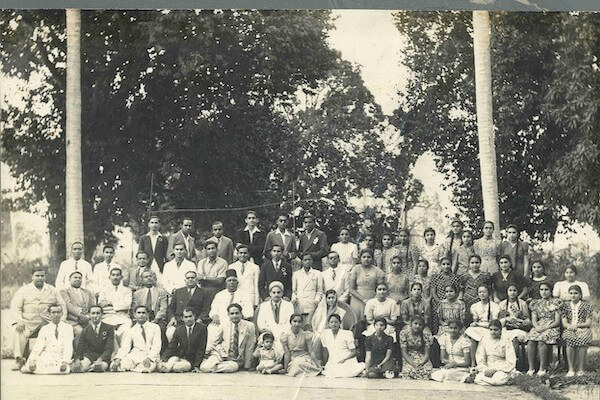
Photo 14
This photos is unquestionably one of the most important photos for the history of the Waezeen in Africa. Tajbibi and Alwaez Abualy are shown with students and officers of the Ismailia Mission Centre, Dar es Salaam, 1948 (or 1949). Notable among them: (Last row): Ismail Ibrahim (third from the left); Lord Amir Bhatia (fourth from the left, presently a member of the UK House of Lords). (Third row): Jaffer Sadiq (far left; Indigenous Ismaili); Alwaez Budhani (eighth from the left); Khanu Hussein Gulamhussein Harji (Moaiz Daya's Maasi). (Second row): Remtullah Walji Virji (third from the left); Jafferali Meghji (fifth from the left); Hussein Jessa Bhaloo (sixth from the left); Alwaez Abualy; Tajbibi Abualy; Gulibai Hirji (maiden name Gulbanu Alibhai Bhatia); Gulshan Sultanali Nazarali Walji (maiden name Gulshan Karmali Jaffer); Gulbanu (Bebla) Hassanali Ismail (Ismail Ibrahim's sister); Kulsum Kassam Sunderji; Fatma Nathoo Nanji (wife of Ismail Ibrahim); Roshan Walji Daya (second from the right, aunt of Moaiz Daya). (First row): Hasanali Walji (far left); Sadru Fatuma Parsi (second from the left); Alwaez Sultanali Nazarali Walji (fifth from the left; husband of Gulshan Sultanali Nazarali Walji); Mohamed Abualy Alibhai (child); Roshan Karmali Bhanji (next to Mohamed), and Shirin Karmali Bhanji (fourth from the right). [The following have helped to identify the individuals in the group: Gulibai Hirji, Lord Amir Bhatia, and Moaiz Daya.] Abualy Collection.
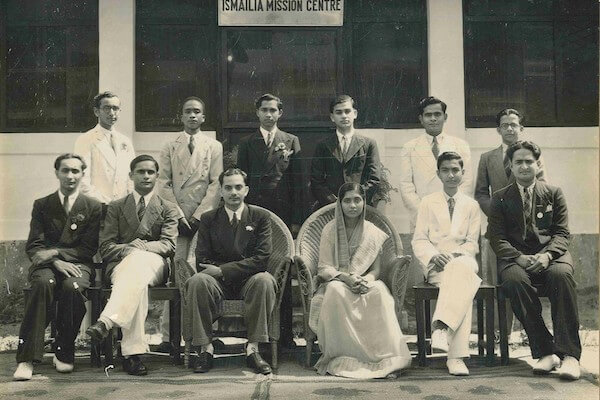
Photo 15
Some of the students of the Waezeen training program with Alwaez Abualy and Tajbibi Abualy. Notable among them was Jaffar Sadiq, the (black) indigenous Ismaili standing second from the left. Abualy Collection.
Tajbibi had to cater to men and women of different ages, and she had to be a competent, gracious and understanding host to all, a sister to some and mother to some, and an administrative assistant to the director, Alwaez Abualy—all at the age of 20.
Gulibai Hirji recalls (in a recent email to Mohamed): "The students at the Mission Centre used to call her ‘Mummy' and so did I. She was a Mom for all of us. Such a kind and beautiful Lady." Gulibai Hirji was one of the few young women who quickly coalesced around Tajbibi and forged close sisterly bonds (dīn baheno) with her.21An early reference to this popular East African fruit occurs in a diary entry of the Christian missionary, Chauncy Maples. The missionary records his efforts to learn Kiswahili. One of the words he sought to translate was “zambarau,” which he describes as “a famous Zanzibar fruit…something like a damson…The tree is one of the finest and tallest that grows on the island.” (Diary entry dated March 28, 1877, in Chauncy Maples: Pioneer Missionary in East Central Africa for Fifteen Years and Bishop of Likoma, Lake Nyasa, 1895, p85.) There is speculation that the word “zambarau” is derived from the Portuguese jambolāo, which in turn is rooted in the Sanskrit jambu. If this speculation is true, then Goa may be the likely source of this fruit found in East Africa.
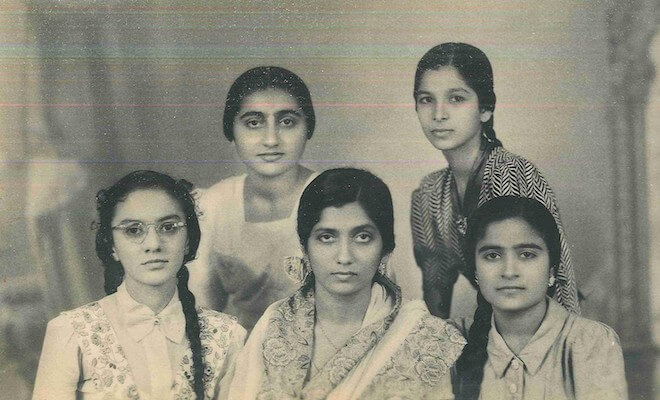
Photo 16
Tajbibi with her friends who were also students at the Ismailia Mission Centre. Kulsum Kassam Sunderji (seated, left), Gulbanu (Bebla) Ibrahim Ismail (seated, right; deceased), Gulibai Hirji (left, back row), and Gulshan Sultanali Nazarali Walji (back row, right). Late 1940s or early 1950s. Kulsum Kassam Sunderji and Gulshan Sultanali Nazarali Walji live in Vancouver; Gulibai Hirji lives in New York. Abualy Collection.
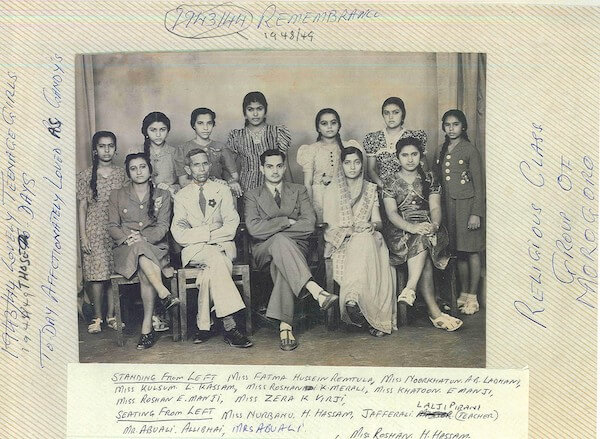
Photo 17
Another major source for a future history of Ismaili religious education in Tanzania: Tajbibi and Alwaez Abualy with students and teachers of the religious education class in Morogoro, Tanzania, 1948 or 1949. Abualy Collection.
Sundowners
Sundowners were occasional picnic-like events invented by the British. "Sundowner was a phenomenon of Colonial rule in India and in East Africa. It was initially started by the Brits, after 4 or 5 PM when they finished their work in government offices. It was always tea with cakes and biscuits. Later it converted into an evening affair with drinks and cocktails and savories. The Asians also adopted the sundowners to invite the white government officials and companies."22Thanks to Lord Amir Bhatia for this information.
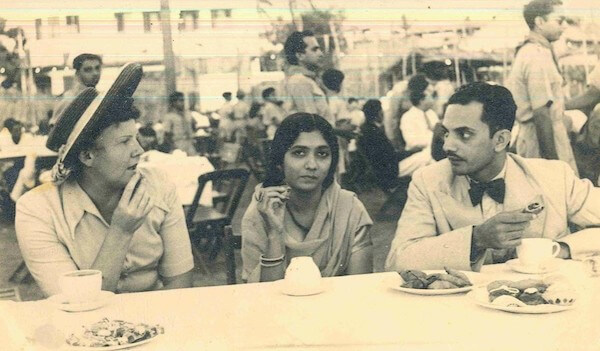
Photo 18
Tajbibi and Alwaez Abualy with a British lady at a sundowner in Dar es Salaam, late 1940s or early 1950s. The boy scouts in the photo suggest that this sundowner was hosted by the Ismaili community. Abualy Collection.
Elderly Swahili Mama Joins the Abualy Household
Concurrent with these responsibilities, Alwaez Abualy began to travel into the interior to deliver waezes (sermons) to the Jamats. Tajbibi was left behind to cope with the Mission Centre students, her own children (she was a mother of three young boys by 1948), and her teaching duties at the school.
The house that my parents moved into was a German-era derelict bungalow in the Upanga area of Dar es Salaam. It now belonged to a prominent member of the Jamat. Alwaez Abualy rented it from him. Upanga later became a stronghold of the Ismaili community in the wake of the new housing scheme launched by Imam Sultan Mohamed Shah. The first group of "Ismaili flats" in Upanga were settled in 1954. Our house was located deep in the bushes, surrounded on all sides with mango trees, tall coconut palms, the odd almond tree, and the zambarau23An early reference to this popular East African fruit occurs in a diary entry of the Christian missionary, Chauncy Maples. The missionary records his efforts to learn Kiswahili. One of the words he sought to translate was “zambarau,” which he describes as “a famous Zanzibar fruit…something like a damson…The tree is one of the finest and tallest that grows on the island.” (Diary entry dated March 28, 1877, in Chauncy Maples: Pioneer Missionary in East Central Africa for Fifteen Years and Bishop of Likoma, Lake Nyasa, 1895, p85.) There is speculation that the word “zambarau” is derived from the Portuguese jambolāo, which in turn is rooted in the Sanskrit jambu. If this speculation is true, then Goa may be the likely source of this fruit found in East Africa. trees that produced succulent bunches of fruit that looked similar to cherries.
The remote and inaccessible location of the house understandably created anxiety over security. A night watchman (askāri) was hired and three fierce attack dogs were brought to keep burglars at bay. With these security measures in place, Alwaez Abualy felt reassured that he could go on his Waez missions into the interior and leave Tajbibi in the safe hands of his younger brother, who was living with them.
There was one additional person in the house who provided reassurance and comfort to Alwaez Abualy and especially to Tajbibi. At the Aga Khan Dispensary—the Aga Khan Hospital had not yet been built—a diminutive Swahili (black) elderly lady, who worked as mid-wife at the dispensary and who had managed the births of my two younger brothers, was invited by Alwaez Abualy to retire and come live with us. Mama, as we fondly called her, was given her own private room (into which I later moved). Apart from helping Tajbibi in the kitchen and feeding us three young boys while Tajbibi was at school, she had no other duties.
Alwaez Abualy then did something truly remarkable. He gave Mama full authority to scold and discipline us, including beating us, if she saw fit. Mama never hit any of us, but she would shout at us if we misbehaved or did something she deemed carried hazard, like climbing the tall almond tree (which I was wont to do in a reckless spirit). I was at the receiving end of most of her scolding.
Mama was a frail short woman, full of wrinkles on her face that testified to years of extreme poverty and hardship. Yet, in what to me is one of the most amazing qualities about Alwaez Abualy, Mama was the only person in the Abualy household at the time who could scold my father without fear (his mother, of course, could do it too, but she joined the household later, as I describe below). This would happen if she felt that he had been too severe with me (I was becoming a discipline problem at home and school and had to be reined in through beatings and slaps to the face). Alwaez Abualy would instantly stop in his tracks, stand before her with his head bowed, and listen to her tirade (in Kiswahili) until she had said enough and walked away. He had given her the status of his own mother. His respect for Mama—who, technically, was a black African servant (āyah)—has remained with me as his most astonishing and noble qualities.
Mama's fortunes changed dramatically after Tanganyika (Tanzania) gained independence in December 1961. One day—sometime in 1962 or 1963—a government Land Rover carrying police officers showed up unannounced at our house. The officers alleged that a relative of Mama in Zanzibar had complained to them that we, the Abualy family, were mistreating Mama. They said that they had come to take her away and send her back to Zanzibar, which they claimed was her original home. To our great surprise, Mama refused to go with them and rejected their allegations against us. She told them that not only was she very happy living with us, but that she wanted to die "here" (at our house). The police would not hear of this. They forcibly seized her—she fought back at them!—and hauled her away.
We never saw Mama again. However, our night watchman, Sulemani, managed to obtain some information through his grapevine. He told us that Mama owned a plot of land (shamba, shāmbā) on the island. The young relative coveted it and cooked up the false charge of abuse as a way to draw Mama back to the island. What did this woman and her accomplices plan to do with her? Did they plan to kill her and grab the land? Did they plan to force her to place her thumbprint on the title document transferring ownership of the shamba to them? Sulemani could not obtain answers to these questions. We have remained in the dark ever since her forcible removal from our home. Curiously, the police never filed any charges against us prompted by these false allegations.
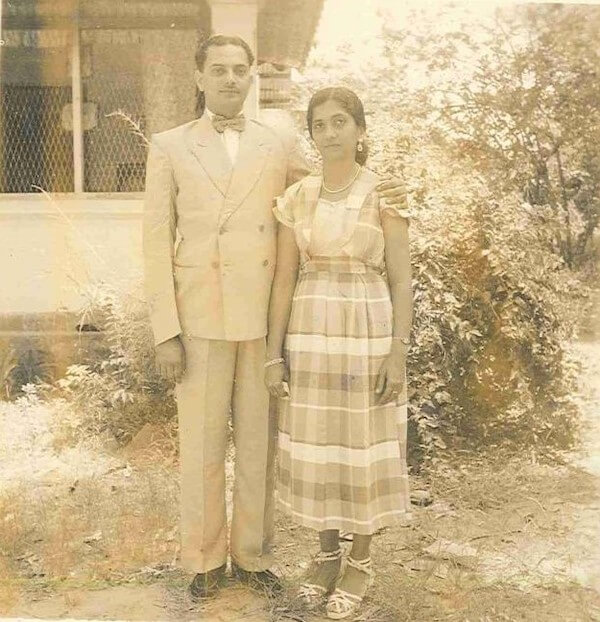
Photo 19
Tajbibi and Alwaez Abualy in front of their house, early 1950s. The upper half of the wall of the U-shaped living room was a wire-gauze net made from small diamond-shaped elements (as shown in the photo). At the bottom right corner, inside the living room (just to the right of Alwaez Abualy's upper right arm), was the PYE radio full of cathode ray tubes at the back. BBC World News at 9:00 PM every evening, after we returned from Jamatkhana services, was a fixture. The world news covered the first nine minutes, followed by five minutes of what the BBC called "Commentary," which was an opinion piece on some international issue delivered by a professor at a British university. Abualy Collection.
Tajbibi the Teacher
Tajbibi's formal education had extended to seventh-grade matriculation level only. But as soon as she arrived in Dar es Salaam, she was called upon by the community's education committee to join its primary-school teaching force because of a lack of teachers. She would end up teaching for nearly twenty years, finally retiring in the mid-60s. During that long period, she taught several generations of pupils (and secondary students), some of whom are leaders of our Jamati institutions today.
Tajbibi was not the only teacher whose schooling did not extend beyond the seventh grade. Most of her colleagues were similarly limited in their schooling. Indeed, when the Aga Khan education board hitched its curriculum to Cambridge University's curriculum for the colonies, the highest grade at the time was the eleventh grade (Form III). The school leaving certificate at Form III was known as Junior Cambridge School Certificate. The education of the administrators of the Aga Khan schools did not extend beyond the eleventh-grade Junior Cambridge School Certificate.
One notable school administrator was Razac Hassam, a fatherly kind man whom I used to visit at his store near Darkhana. He was the administrator of Tanzania's Aga Khan schools, yet his own schooling had ended at Junior Cambridge. In spite of these formal educational limitations, Razac Uncle (as I and my friends called him) had been very conscientious about his responsibilities and had done his due diligence in informing himself about A levels (Forms V and VI) and university education. He offered advice on post-secondary education with a combination of humility, knowledge and confidence, and he did not hesitate to offer advice to students like me whose formal schooling (Forms IV through VI) had outstripped his own.
When the new boys' school opened in 1958 on Cameron Road (later renamed United Nations Road) that linked Morogoro Road to Upanga Road near the Salendar Bridge, the school's entrance hallway carried a huge wooden plaque listing the names of Junior Cambridge alumni. There were no grade twelve (Form IV) alumni at the time. By 1964 the school had graduated its first batch of Form VI science students.
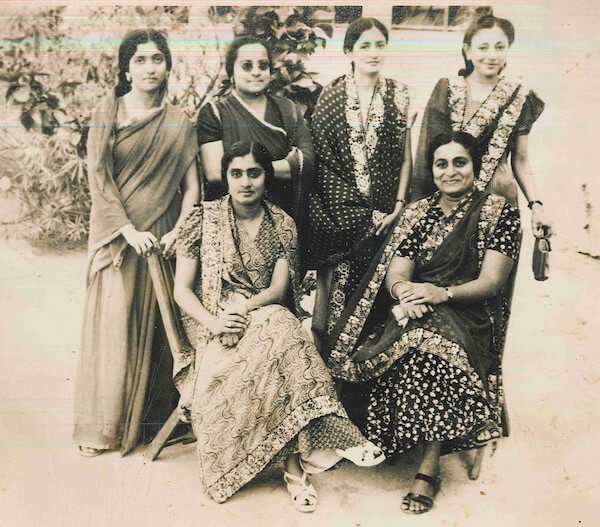
Photo 20
Tajbibi with fellow teachers of the Aga Khan Primary School, Dar es Salaam. Sakarben Lila, one of her closest friends, is seated to the left (Tajbibi has her hands on Sakarben's chair). Sakarben was a rock of emotional support for Tajbibi during her years of suffering. Already in this photo and the following photo, Tajbibi's unsmiling sad face and eyes betray her unhappy internal life. Late 40s or early 50s. Abualy Collection.
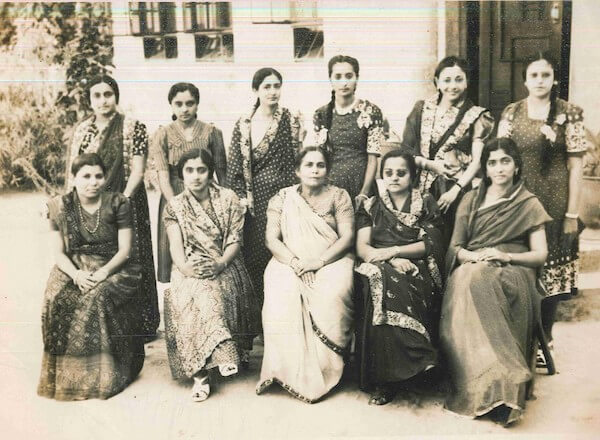
Photo 21
Tajbibi with fellow teachers at the Aga Khan Primary Girls' School, Dar es Salaam. Late 40s or early 50s. Abualy Collection.
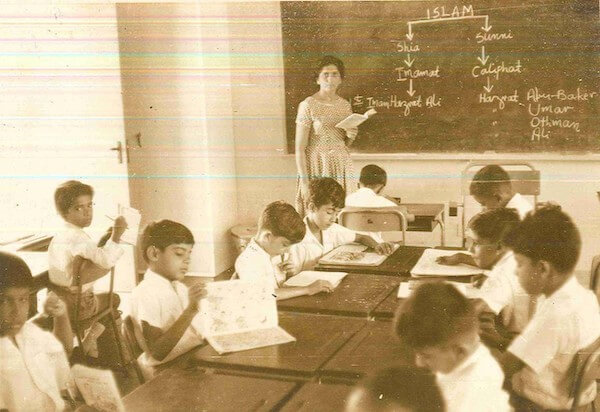
Photo 22
Tajbibi teaching religion class at the Aga Khan Boys' Primary School, Dar es Salaam, mid-1950s. The dress ("frock," as it was popularly called) that she is wearing suggests that the photo was taken after 1952. In that year, Imam Sultan Mohamed Shah had circulated a photo of himself and Mata Salamat Om Habibeh that showed Mata Salamat standing beside the seated Imam, wearing a dress that reached just below the knee. The Imam wanted his women followers to adopt what he called "simple colonial" dress (he wrote his message on the photo). The impact of this Farman was instant and sweeping among young women and girls. Abualy Collection.
By today's standards, our university-educated young men and women may look back at these teachers with their seventh-grade and Junior Cambridge education with a kindly and condescending dismissiveness. They would be missing something important about these "blind leading the blind" teachers: these teachers more than made up for their lack of grade-twelve education by the immense personal effort they expended in self-study aimed at acquiring new knowledge. But they did more than that: they regarded each pupil as their own child and took a keen parental interest in their intellectual and moral development. They could do so because these teachers enjoyed the unconditional support of the parents and community institutions. [I will present a fuller treatment of this topic in Part Two of my remembrance.]
A Beloved Teacher Remembered by Colleagues and Students
As I have already mentioned above, Tajbibi would go on to serve as teacher for nearly twenty years. She taught boys and girls, and many of them remembered her fondly and came forward from all parts of the world to express their sorrow and offer their condolences when they learned that she had passed away.
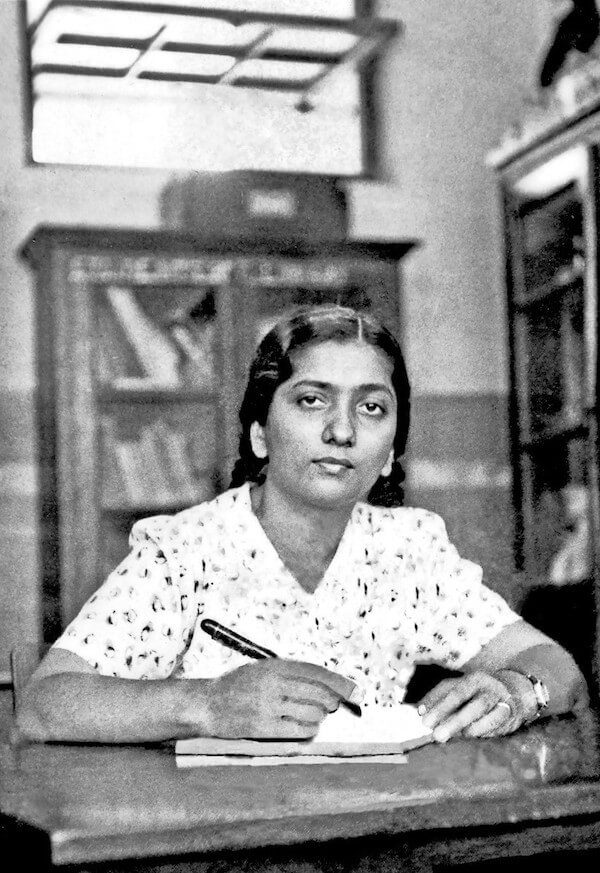
Photo 23
Although she was based at the Aga Khan Primary School, Tajbibi occasionally came to the Boys' Secondary School as a substitute teacher. Here she is in the staff room of the Aga Khan Boys' Secondary School, Dar es Salaam, 1960. Abualy Collection.
Tajbibi was universally loved and respected by her colleagues. Her male colleagues at the legendary Aga Khan Boys' Secondary School—Mr Khan, Mr Kabir, Mr Fernandes, Mr Shaw, Mr Carvalho, Mr Almeida, Mr Kanga, Mr Gregory (the English principal), and others, all non-Ismaili)—showed tremendous affection for Tajbibi and treated her with great respect and fraternal solicitude. Of them all, it was Mr Khan, my physics teacher and class master in Forms III and IV, who held a special brotherly regard for Tajbibi, and when her hour of need arrived, it was to him that she turned for help. [I say more on this "hour of need" below.]
Her students and colleagues would fondly remember her even decades later. Two events, in particular, testify to the lasting respect and affection in which she was held.
The first event occurred on Zanzibar Island a few weeks before the Zanzibar Revolution in early 1964 (I was in Form VI). I and three other students from our school were selected to play for the Dar es Salaam cricket team in an intercity match against Zanzibar. We flew to Zanzibar. During our flight the team was entertained by the mellifluous singing of Oldies Goldies Hindi songs by Nazir Hussein from the Ithnashari team. The Jamati leaders of both Jamats—Dar es Salaam and Zanzibar—had worked together and arranged for the Ismaili students to be hosted by the famous Bhaloo family on the Island.
Next morning we headed for the Sayyid Khalifa Stadium, where the cricket match was to be played. When we arrived at the stadium, I was surprised to see Mr Gregory there. Mr Gregory had been the headmaster of our school in Dar es Salaam. We knew that he had left the school, but we did not know where he had gone. Here he was, in Zanzibar. I saw him chatting with some people. Suddenly one of the men pointed toward me. Mr Gregory turned and saw me. He walked over, greeted me and my fellow Ismaili students and told us how proud he was that the Aga Khan School had sent the largest contingent of players to the Dar es Salaam cricket team. He explained that he was now in Zanzibar because he had been asked by the administrator of Aga Khan schools to take over as headmaster of the Aga Khan school in Zanzibar.
Then Mr Gregory turned to me and asked me if I was "Mrs Abualy's son." He did not ask, "Are you Mohamed Abualy?" He asked me if I was Mrs Abualy's son. I said I was. Mr Gregory had a rugged freckled face topped by carrot-colored hair. True to form, as he always did, he wore khaki shorts and white shirt, the dress of colonial officers. He told me that he came to the stadium after he read my name listed (in the Dar es Salaam team) in the local newspaper. He said he wanted to meet me to tell me how much he remembered my mother, what a good teacher she was, and that he wanted me to convey to her his warm regards and respects.
The second event occurred in Toronto in early 2002. I was given a tour of the Khoja Ithnashari madrasa (Sunday) classes at the great Jaffari Masjid in Toronto. These classes were the equivalent of the Ismaili community's BUI (Bait Ul Ilm). There were separate classes for different age groups (separate for boys and girls), all the way for Grade 12 students.
My extremely warm, helpful and brotherly escort stopped at a class for the Grade 12 boys and asked me to wait outside as he walked in. He came out accompanied by the teacher, whose name was Raza. He explained to Raza that I was conducting research on religious education programs among Canada's Muslim communities, including the Ithnashari Jamat. He told Raza that I was from Dar es Salaam.
Raza turned to me and said that he had been a student at the Aga Khan Boys' Primary and Secondary Schools in Dar es Salaam. He said that of all the teachers who had taught him, there was one whom he still remembered (in 2002) because she was not only a very good teacher but also a very loving, caring and kind person.
Then Raza said, "Her name was Mrs Abualy. Do you know her?" It took me a few seconds to collect myself from the emotions that had overwhelmed me. "That is my mother you mention," I said, holding back tears.
Civic Engagement: Founding Member of the Muslim Women's Association
Soon after arriving in Dar es Salaam and settling in her new home in Upanga, Tajbibi became active in civil society work by joining with some Muslim women to establish the Muslim Women's Association. She was elected its General Secretary.
One notable event organized by the Muslim Women's Association was a banquet in honor of Begum Siddiq Ali Khan, wife of the Pakistan High Commissioner to Tanganyika.
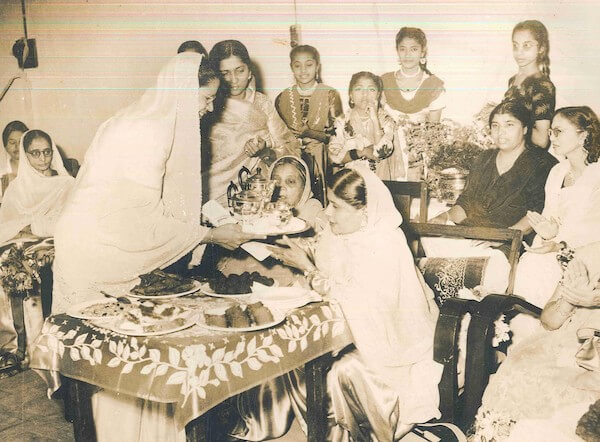
Photo 24
Tajbibi Abualy (standing, looking on) at a party organized in Dar es Salaam by the Muslim Women's Association in honor of Begum Siddiq Ali Khan, wife of the Pakistan High Commissioner, Nawab Siddiq Ali Khan. Early 1950s. Abualy Collection.
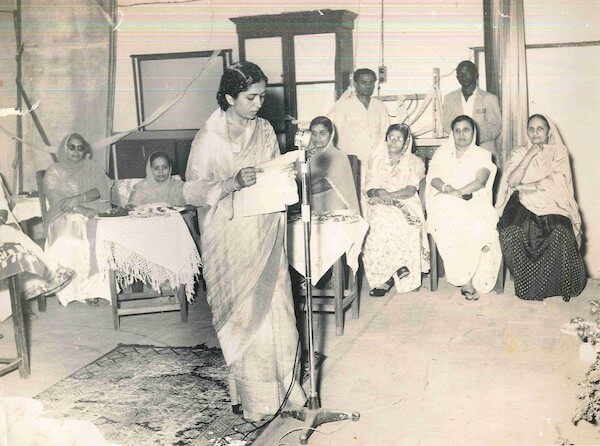
Photo 25
Tajbibi was one of the founders of the Muslim Women's Association in Dar es Salaam and was elected its general secretary. Here she is delivering a speech at one of the group's meetings. Late 1940s or early 1950s. Abualy Collection.
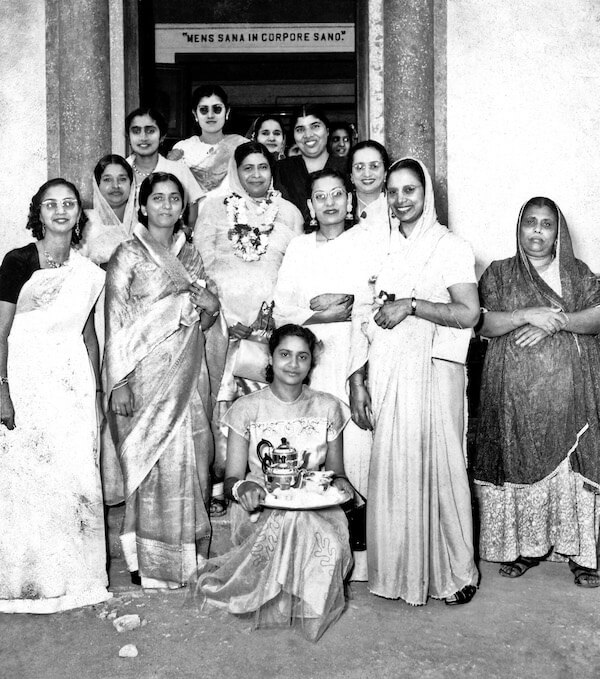
Photo 26
Tajbibi (front row, standing second from left), the general secretary of the Muslim Women's Association, welcoming Begum Siddiq Ali Khan (garlanded), wife of the Pakistan High Commissioner to Tanganyika, early 1950s, at the Aga Khan School in Dar es Salaam. Above the inner entrance is a Latin maxim that Imam Sultan Mohamed Shah had designated as the motto for all the Aga Khan schools. The words "Mens Sana In Corpore Sano" mean "A Healthy Mind in a Healthy Body."
Years of Psychological Abuse, Humiliation, Hardship44This extended section does not include any photos, which reappear in subsequent sections.
I come now to that part of Tajbibi's life which has proved very vexatious for me and that has presented me with a moral dilemma, a dilemma that I, as her son who has committed himself to giving her the voice that she did not have in life, have had to grapple with and resolve, not to anyone's satisfaction, but to what I intuit as my mother's satisfaction.
Stated in plain language: I cannot speak about the abuses that were inflicted on my beloved mother which she, Sita-like, silently endured, without in some way drawing into my narrative of her life those who inflicted on her these torments and cruelties. The events and incidents concerned reach back to the mid-50s, although their impact on my mother left a permanent wound in her soul. Some of the perpetrators are no longer with us, whereas those who are still alive will clearly resent being dragged into the public eye. All I will say to them is that it is impossible for me to leave out from my account of her life this abuse, which was central to how she experienced her family life. What I have to say is not mere hearsay on my part. I was old enough at the time to have witnessed what was happening to my mother, and to have understood that what was happening to my mother was abuse pure and simple. Even I was subjected to physical abuse by some of the in-laws.
Before I proceed with an account of this part of her life, I want to say a few words about two aspects of Tajbibi's marriage that provide a partial and mitigating explanatory cultural framework for why she suffered these abuses. This framework does not entirely exonerate the perpetrators, but it does at least enable us to view them and their actions as products of deeply entrenched social structures, beliefs and norms in traditional Indian society.
The sasurāl-bahu Model
The first of these two aspects is the culture governing the daughter-in-law's life within her in-law family. The social form of this relationship is known as the sasurāl-bahu relationship. The in-laws are the sasurāl, and the daughter-in-law is the bahu. The sasurāl-bahu model is a structural feature of the Indian family. It is ubiquitous all over India. Structurally, the girl physically must leave her biological family and move in with her in-laws. But she does not just change physical residence. The culture governing the sasurāl-bahu model requires the bahu to place herself under the supreme authority of her mother-in-law, whose commands she must obey. She must accept her mother-in-law (sās) as her real mother from now on, and she must sever her links and affections for her biological mother.24This characterization of the sasurāl-bahu family structure is a generalization. Many bahus enjoy a loving relationship with their in-laws. Nor does every bahu move into the household of her in-laws. These exceptions to the rule are found in cosmopolitan cities like Mumbai and New Delhi. The sasurāl-bahu model is the norm in rural India, where the vast majority of the population lives. From personal experience living in a Khoja Ismaili community in Dar es Salaam, I would venture to remark that the grip of the model was weaker among them than it was among the Punjabi Ismaili Jamat in Punjab. This subject merits a comparative doctoral-level study.
Of all the adaptations that the bahu must make in her new family, the one that brings the bahu most directly under the authority and surveillance of the mother-in-law is the kitchen (and washing clothes). The bahu must carry out a range of household chores and duties that were carried out by the mother-in-law and her daughters—and even by the servants, among whom she is conceptually assimilated as the bahu-servant—before the bahu entered the family. In practice, then, the stranger who comes into the family as bahu becomes more a servant than a bona fide equal member of the family, enjoying the same love, care, consideration, honor, respect and indulgence as do the daughters of the in-law family. Hundreds of millions of bahus in Indian society are fated to a life of slavery, of trapped servitude inside the sasurāl-bahu social microcosm. The internet is full of young freshly married women, many mere teenagers, complaining about their mother-in-law and seeking practical advice on how to overcome their problems.
Under no circumstances must the bahu leave her in-laws and return to her birth family. She may have been mistreated by them, but she must put up with this abuse and, Sita-like, carry out her bahu duties silently and diligently. Indeed, she must not do anything to provoke them into abusing her even more. A bahu who flees her in-laws is an instant disgrace to her family's reputation, for she destroys the marriage prospects of her sisters.25One of my coworkers during my IT career was a Sikh from Chandigarh, capital of (Indian) Punjab. He went back to India to marry the girl he loved. While he was still in India, he sent us digital photos of the wedding ceremony. When he returned two weeks later, he was alone. He explained to me that his wife, the bahu, had to remain behind because she had to learn the family traditions from his mother. He and I shared the same cubicle, and our workstations were next to each other. About two weeks later, the phone on his desk rang. He spoke in Punjabi, which I cannot speak fluently but can understand. He was livid, shouting at the person at the other end. He was demanding that this person go back. Otherwise, he threatened, “I will divorce you.” He hung up, unable to calm down, his face exploding with anger. He turned to me and told me that his wife had called him from New York—New York!—and informed him that she could not take her mother-in-law’s abuse anymore, so she had fled the household in Chandigarh and had landed in New York on her way to be with him in Olympia (Washington) [I was living in Olympia at the time]. He took time off again from work and went back to Chandigarh. He swiftly divorced his wife and returned with a new bride. He told me in a firm voice, “I will not tolerate my wife complaining about my mother.”
Imam Sultan Mohamed Shah, ever so tremendously insightful, writing about the status of women in India in his book India in Transition (1918), made the following observation:
Generally speaking the Hindu joint-family system, as petrified by case-made law, operates to turn widows and married women into either domestic tyrants or slaves. [pp. 258-259; emphasis added by me]
In speaking of the "married woman," the Imam is referring not just to the bahu, but also to the sās (mother-in-law). It is typically a zero-sum game: if the mother-in-law is the tyrant, then the bahu is the slave, and if the bahu is the tyrant, then the mother-in-law is the slave. Which of these two alternatives is the outcome depends crucially on the son. A strong-willed bahu may succeed in "capturing" the son and, through his passivity, dominate and bully her mother-in-law—he is a weak son. Conversely, the mother-in-law may retain her hold over her son after his marriage and, again through his passivity, bully and mistreat her daughter-in-law—he is a weak husband. The weak son is weak in his relation to his mother but not weak in relation to his wife, whom he too may mistreat.
As Imam Sultan Mohamed Shah rightly observed, the joint-family system (sasurāl-bahu system) can turn the bahu into a tyrant or a slave. Indian films for decades have grounded their plots on the sasurāl-bahu family system and have made the relations between sās (mother-in-law) and bahu (daughter-in-law) the driver of plot development. It was Tajbibi's great misfortune that she married into a family in which the mother-in-law, aided and abetted no doubt by her relatives and by her own husband, became an all-powerful dominatrix over her and turned her into a slave.
Homology between the Caste System and the sasurāl-bahu Family System
The ubiquitous and deeply ingrained sasurāl-bahu family system and its structurally fostered domestic cultural system cannot be understood without also examining its place within the wider caste system in India. The caste system is the hierarchically ordered social embodiment of a theory of inequality-at-birth. Humans are born unequal, and their place, privileges and duties in society must be commensurate with this "birthright" inequality. This principle of inequality, which governs the caste system, imbues the individual with an inegalitarian outlook toward fellow humans—one is either above others or below them, but not equal to them. Even members of an upper caste constantly jostle to establish a hierarchical, inequality-based, relationship among themselves.26The most incisive and, as yet, unsurpassed study of the principle of inequality-at-birth and its social expression in the caste system is that of Louis Dumont, Homo Hierarchicus: The Caste System and its Implications (1966). Dumont subsequently published a second edition of the book (1980) in which he responded to the discussions within the academic community prompted by his provocative and controversial thesis.
The sasurāl-bahu family structure, which proved so oppressive to my mother, is, from a straightforward sociological consideration, a microcosm of the all-pervasive caste system in Indian society. It may have only two "castes" in it—the sasurāl (in-laws) and the bahu (daughter-in-law)—but it reproduces in this microcosm the fundamental value system that undergirds the wider "macrocosmic" caste system in Indian society. The key principle that engenders this homology between the family and the societal caste system is the role that the in-laws impose upon the bahu: they demand from her that she perform tasks for them that are performed by the sudra caste in the wider society. Whereas in the external wider caste system there are the three dominant castes—Brahmins (priests), kshtrayas (warriors) and vaisyas (merchants)—these three formal categories are fused into one de facto "upper caste" category, the sasurāl. The bahu becomes a one-person sudra caste laboring like a "slave" (as Imam Sultan Mohamed Shah put it) for the comfort of her in-laws.
There is a second principle that corroborates my homology between the family as a microcosmic caste system and the wider "macrocosmic" caste of Indian society at large: members of the upper caste do not think that they ever behave badly toward the sudra caste. The concept of guilt is foreign to them. They only respond to shame. The former is an individual's sensitivity and responsiveness to his or her own conscience. The latter is an individual's sensitivity to others' opinion about him, to his image among them, to his standing among them, all of which he wants to protect. In guilt, one punishes oneself. In shame, one fears retribution from society that has been offended by his conduct, and it is this fear of offense taken by society that evokes the feeling of shame in him. Guilt is directed inward, shame is directed outward. In guilt, moral accountability is directed inward, to the judgment of one's conscience; in shame, moral accountability is directed outward, to the judgment of others.27Salman Rushdie fails to distinguish between guilt and shame in his highly acclaimed 1983 novel, Shame.
No matter how atrocious, cruel and injurious the actions of the upper caste toward the slaving and powerless sudra caste, the notion of a conscience-stricken guilt is foreign to them. It is out of the question for them to feel remorse and guilt and to apologize to their victims for the emotional, physical and financial harm they have inflicted on the sudras. Indian films constantly depict these realities in their stories.
Both these key factors in the microcosmic sasurāl-bahu caste system were active and played a decisive and damaging role in my mother's life. For example, none of them—those who have passed on and those who are still alive—has ever expressed remorse, regret, or apology for their treatment of her, nor has any of them expressed any gratitude or appreciation for all that she did for them. This behavior is fully consistent with the ethical logic of macroscopic inter-caste relations, a logic that is reproduced in the microcosmic sasurāl-bahu caste system. [It bears repeating here that it was my mother's wedding jewelry and her salary from teaching that brought them to Africa and that nourished and sustained them even as they abused her.]
The contrasts between the respective mothers—her husband's mother and her own mother—could not have been starker and could not have failed to register with Tajbibi. One mother (Tajbibi's) was a compassionate if easily bullied woman who adopted orphans without regard to whether she would have the wherewithal to care for them. The other mother (Tajbibi's mother-in-law) rejected Tajbibi as a bona fide full member of her family and, catastrophically for Tajbibi, confined her to the toilets used by the servants. Her mother-in-law was, and remained till the end, ungrateful and cold-hearted toward Tajbibi and drove her like a slave master drives his slave. Yet she would not have been free to mete out her cruel actions on Tajbibi had the rest of the Aziz family, including, I am sad to say, her own husband—who cut a Ram-like figure, putting his loyalty to his family and family norms ahead of his obligations to his vulnerable, defenseless and bewildered young wife—stepped in to protect her.
The Animus Toward the Khoja
Contributing and reinforcing her in-laws' attitude and conduct toward Tajbibi was the animus toward the Khoja that they harbored. Whether this animus was a general feature of the Punjabi Ismaili Jamat or not remains an unanswered question for me. But I can say with the certainty of someone who has heard such sentiments expressed by some of them—khoje log zaeef hain ("the Khoja are a weak people")—is that it was a firmly held view within Tajbibi's in-law family. This superiority complex to their Khoja brethren—an unedifying aspect of intra-Ismaili relations within the Indian Jamats—hardened the in-laws' dislike for Tajbibi and exacerbated their mistreatment of her. [Yet, in a great irony, all Tajbibi's brothers-in-law and sister-in-law ended up marrying Khoja partners. Well they might: the Khoja Jamat in Africa was a flourishing Jamat. Marrying into them was to marry up economically.]
The Beginnings of Abuse in Africa
I have already recounted the monstrous "toilet" humiliation that my mother suffered at her in-laws' home in Amritsar; and I have also remarked that Tajbibi regarded her transfer to Africa (as per Imam Sultan Mohamed Shah's instructions to her husband) as her opportunity to escape from the clutches of her in-laws. She was sorely mistaken in this belief.
Tajbibi and Alwaez Abualy (along with me, a six-month child) left India before Partition tore asunder the Muslims and Hindus. At Partition, some of Alwaez Abualy's family fled south to Mumbai, where they were welcomed and hosted by Tajbibi's parents and brothers. Others, especially the daughters, were already living in areas that would fall on the Pakistan side of the border. Alwaez Abualy's younger brother had moved to Mumbai to avoid the blood bath. [Alwaez Abualy told me on several occasions that Imam Sultan Mohamed Shah had advised the Punjab Jamat living in what would become the Indian part of post-Partition India—for example, Amritsar—not to go to Pakistan but to go to Africa. The move to Mumbai was a step toward migration to Africa.]
Soon after Partition, Alwaez Abualy brought his younger brother to Dar es Salaam to stay with him and Tajbibi. This younger brother, Tajbibi's eldest brother-in-law, had exhibited the strongest animus toward his new Khoja sister-in-law. Now here he was, in her home in Dar es Salaam. But the "power logic" of the sasurāl-bahu model is a cultural characteristic: it is invariant with respect to physical location. Her brother-in-law may now be living in her home, but he was the sasurāl man, and as such he still retained the culturally sanctioned right to be her lord.
Although the Aziz family (Tajbibi's in-laws) was given to a higher than average level of temper, Tajbibi's brother-in-law exceeded them with his vile temper that he directed toward his powerless and weak sister-in-law. He was a bully pure and simple, striking fear into Tajbibi's heart and crushing her spirit. Alwaez Abualy had brought his younger brother to live with him to ensure that there was a male figure at home as he embarked on his Waez tours that took him as far as the Congo and South Africa. The younger brother thus found himself alone with Tajbibi and could wantonly dump his vile temper on his helpless sister-in-law who cooked for him, washed his bed sheets and took care of his other chores like washing, ironing his clothes and preparing the hot water for his bath.
A feature of the sasurāl-bahu model of the family is that it grants the husband's male siblings the right to "discipline" the bahu, striking her if necessary.28During the mid-70s in Cambridge (Massachusetts), when I was a graduate student at Harvard, a young Ismaili couple from Pakistan arrived in Cambridge. The wife had Bollywood good looks and flowing black hair; she always wore an elegant sari. The husband had joined MIT’s MBA program at the Sloane School of Management. His younger brother was living with them. It did not take long for some of us—we were a small student Jamat of about 15, gathering at MIT once a week for prayer services—to learn that the younger brother was beating his sister-in-law. When the wife finally opened up to us, she told us that her husband supported his younger brother’s actions, saying that he had the right to beat her. She had no marketable skills, was already the mother of a young girl, and had grown up in Pakistani society with traditional conceptions about stay-at-home mothers. In spite of these constraints, she eventually divorced the husband and became brave enough to live alone (with her young daughter) in the greater Boston area. I and a group of Ismaili students would visit her on weekends during the summer breaks and spend a few afternoon hours at her home playing Monopoly. Tajbibi's brother-in-law never lifted his hand to strike her, but he did view himself authorized by the norms of his own family to act as the "stand in" husband-lord in the absence of his brother.
This was the pattern of life for Tajbibi during the years 1948 and 1953 (when the other Aziz family members joined the Abualy household). Alwaez Abualy was gone on his Waez tours believing that he was leaving his wife in the safe care of his younger brother. The Abualy home was tucked deep into what local parlance would call the "jungle," cut off from the city and from the Jamat. It was not just a fearful place at night, it was also a prison from which Tajbibi had no escape from the harsh manner in which her brother-in-law treated her.
The only relief she found lay with the Waezeen students who showered her with love and respect. Although the majority of them lived in the city and returned home after classes, there were a few "foreigners" from the interior Jamats who lived in the dormitory component of the Ismailia Mission Centre building, a bungalow about half a mile from our home. One special student was the black indigenous Jaffer Sadiq. Alwaez Abualy occasionally asked him to stay with Tajbibi and her brother-in-law during his absences. Jaffer Sadiq was a very sensitive, caring and humane young man, and he treated Tajbibi with the kind of brotherly love and respect that he showed to his own sisters. These Waezeen students, especially Jaffer Sadiq, did a lot to soften the pain of her brother-in-law's vile temper and bullying.
The In-Laws Join the Abualy Household in Dar es Salaam
In 1953 Alwaez Abualy decided to bring his immediate family to Dar es Salaam. All together five new members from the Aziz family were added to the Abualy household.
An obstacle to bringing them over was lack of adequate funds. Alwaez Abualy was a very frank speaker not given to diplomatic niceties or concern over ruffling leadership feathers. His Waezes occasionally provoked strong reaction from sections of the Jamat and the leadership. This would happen when he said something controversial. Invariably the leaders responded by suspending his pay, which caused great hardship to my mother who had three very young sons and her brother-in-law to feed, not to mention feed her own husband and herself. The family could not pay the school tuition fees, as a result of which we would be sent home. Although her brother-in-law worked at a store in the city, he did not share any of his salary with Tajbibi. To add to the woes regarding school, Tajbibi did not have sufficient funds to pay for our school uniforms or buy shoes. I remember going to school without shoes. Mercifully, some fellow teachers of Tajbibi would donate their children's hand-me-down clothes to her for us to wear to school.
Alwaez Abualy may have decided to bring his family over to live with him, but he could not on his own cover the expenses involved. In order to meet the expenses of bringing them over, Tajbibi, Sita-like, sold some of her wedding jewelry and gave the money to her husband.
No sooner were they settled than they began treating Tajbibi as a slave who had to be at their beck and call all the time. Every individual among the in-laws, including Alwaez Abualy's youngest sister who was barely twelve at the time and was 15 years younger than Tajbibi, showed contempt for her and used harsh language toward her. She had to cook for them, do all the chores of the household, care for and feed her own children and the boarders, and teach at the Aga Khan Girls' Primary School.
(More out of financial desperation than for any other reason, Alwaez Abualy started hosting young girls and boys from the interior, where parents were keen to send their children to the city to obtain education that was unavailable in their small town or village. These boarders, especially the girls, needed much sensitive emotional care in addition to good nutrition, etc. The parents had to be reassured that their children were being treated well. These tasks fell on Tajbibi's shoulders, which she, again Sita-like, discharged with compassion and diligent care.)
It did not help Tajbibi's sense of being weighed down by these new loads on her shoulders, that she was seven months pregnant with her fourth child. In March 1953 her mother arrived from Mumbai to be by her side during her pregnancy and to help care for the new baby. That same year Tajbibi's eldest brother-in-law got married. The new bride now joined the Abualy household. Suddenly, within a matter of a few weeks, Tajbibi had to cater to over 20 individuals, including a newborn girl. She was overwhelmed by this large household. She had to go to school during the day and come home at mid-day fatigued and begin all sorts of chores and demands from the in-laws, the boarders and her own children.
Her in-laws were indifferent to Tajbibi's workload. They had been hostile to Tajbibi as their bahu, a Khoja girl from Mumbai. They now resented the presence of Tajbibi's mother. They ganged up on her and bullied her with harsh language and contempt. As I have already remarked above, Tajbibi's mother was a very compassionate but easily bullied timid woman. Within a month, unable to bear the abuses directed at her, she had fled back to India. Tajbibi delivered two months later and had to cope without the support of her mother. [During the month that my maternal grandmother lived with us, she taught me the Gujarati script, a precious gift upon which I subsequently built my knowledge of the Gujarati language and access to Gujarati literature, especially the Ginans.]
It was bad enough that her in-laws were harsh with Tajbibi and treated her like a slave. The Abualy household was perpetually short of money to cover fully the expenses incurred in catering to the needs of twenty individuals. One dire consequence of this lack of money was that her brothers-in-law were constantly undernourished. The parents and sisters-in-law were given priority in matters of food. The boarders were also given priority. The ones who were left with little to eat were I and my two siblings and the three brothers-in-law. Tajbibi herself was the most underfed. This state of hunger led some of my uncles (Tajbibi's brothers-in-law) to snatch morsels of food from my plate and my brothers' plates. [Occasionally, no doubt out of frustration, one or the other uncle would lose his temper over some trivial thing and slap me on the face.] Tajbibi, seeing what was going on, decided to shield us from these acts of predation by her brothers-in-law. She would take us into her bedroom and make us slide under the bed and lie on the floor. She would then feed us with the little that was left after the high priority individuals had been fed—khichdi sprinkled with some sugar (milk was too expensive), plain boiled rice, fried potatoes, the rare roti, etc.
Of all the images of those days that I see vividly even today, it is the one in which my mother, after everyone had been fed, sat alone at the dining table, making do with the crumbs that had been left over or, if there was nothing for her to eat, eat some fried chillies with a roti. Occasionally she would heat up a tablespoon of gur (jaggery) in a few drops of oil and eat it with roti. Her mother-in-law and young sister-in-law used the kitchen while Tajbibi was at school, but the food they prepared was for their own family only, never for her or her children.
True to her Sita personality, Tajbibi's compassion and kindness extended even to her mother-in-law in her hour of need. Her mother-in-law developed Parkinson's disease with advancing years. Caring for her was not easy. Her dislike and rejection of my mother as her bahu had remained as strong as it was on the day when my mother showed up at her home in Amritsar and she had prohibited my mother from using the family toilet. Unwilling to be cared for by my mother, she sought out her other sons and leaned on them to overrule their wives (her bahus) and take her in, knowing full well that these bahus, not her sons, would end up having to care for her.
She moved in with one son in London, then to another son, also in London, then to Nairobi with yet another son. In every case she complained to my father of not being treated well by her daughters-in-law. She wanted to come back and now wanted my mother to care for her. She wanted to be cared for by the very daughter-in-law whom she had humiliated in Amritsar, whom she had never accepted as her daughter-in-law, whom she had never liked or loved, and whom she had bullied and mistreated all her life. My mother, for her part, had welcomed her mother-in-law's departure and was not happy at the prospect of having to care for someone who despised her. Her mother-in-law, for her part, may have rejected my mother and may have worked her like a slave, but she knew that she could trust my mother to properly care for her. And that is how she spent her final years, with progressive Parkinson's disease, living with my parents and being cared for by my mother.
There is one other episode in my mother's life that sheds a different kind of illuminating light on her remarkable compassion. Our home was an old German-era bungalow. Its floor was above the ground by about 4 feet. A concrete stairway of 4 or 5 steps, about 5 feet wide, had been built outside the main entrance: visitors climbed the steps to reach the main door. In due course, due to shifting soil underneath this external stairs, a crack or a fault had appeared between the house and the concrete block of stairs. One day my mother noticed baby snakes when she peered down into the crack. As she investigated this surprising discovery, she found that a female snake had set up her domicile underneath the stairs. She had obviously been pregnant and had searched for a safe and cozy hideout to deliver her babies. Although our home was occasionally infiltrated by deadly snakes, my mother determined that these "guests" were not deadly. She decided not only to let them live there but showed concern for the well-being of the baby snakes, making sure that they were not harmed and were doing well. And she forbade others, including my father and the servants, from killing them, harming them or "evicting" them. Visitors who walked up the stairs and stepped over the crack into the living room had no clue that they were stepping over a family of snakes under their feet. [The new owner of the house, after my parents moved to Canada, cut down all the trees and removed the front stairs. The snakes may have escaped to safety or they may have been discovered and eliminated by the new owner. My mother did not know their fate.]
Returning to her in-laws: Not once in all these years did anyone say a kind word to her or thank her for what she was doing for them, nor did they help her with any of the cooking or chores. All the three brothers-in-law and sister-in-law went on to establish and enjoy at least an upper middle-class life in Britain, Canada and the US. One of them may well be a billionaire today, another a millionaire, the others own their own homes and enjoy the benefits of living in advanced societies with the best educational institutions for their children and grandchildren. It did not occur to any one of them, and it has still not occurred to any of them, even after the passing of Tajbibi, to offer a modicum of appreciation and express some words of gratitude for the prosperity whose foundations were laid by my mother's jewelry, salary and cow-like yoked labors on their behalf.29My mother’s in-laws may have viewed her sale of part of her wedding jewelry to raise the funds for their migration to Africa as part of her dowry. She was simply doing what they expected the bahu to do, to bring in money, in which case the question of gratitude, appreciation and respect does not arise for them.
Such are some of the built-in temptations to abuse and cold-heartedness of the sasurāl-bahu form of the Indian family (as Imam Sultan Mohamed Shah recognized). Her in-laws were not innately mean. The power asymmetry in the sasurāl-bahu family system endowed them with power over the bahu, and they succumbed to this temptation under some enabling conditions—for example, their constant undernourishment and their animus toward a Khoja bahu—and behaved toward her in ways that they might not have behaved under a more congenial and egalitarian family model.
The sparkle had gone from my mother's eyes because it had gone from her soul. Almost without exception, all her photos, even those taken on happy occasions, betray her inability to summon that missing sparkle and happiness to her eyes, face, and lips. The most painful of these for me is the one at the top of this essay.
Years later, after she had settled in Burnaby (British Columbia) and was blessed with the Jamat's respect and affection, the spirit-killing memories of these cruelties remained fresh in her mind and soul. She recounted to me on many occasions these abuses. She would say to me, Kisko padi hai mere par kyā zulm huā hai? [Who cares about how I have been cruelly treated?]
Nurbanu Bhanji: Extraordinary Soul
In the midst of this multipronged psychological abuse, suffering and hardship, and as if in answer to her silent Draupadi-like cries for help, Tajbibi met a new neighbor in the Upanga Jamatkhana. Nurbanu Bhanji was a remarkable woman. She had a very compassionate heart and a sharpened capacity for intuiting another person's suppressed distress and becoming distressed herself. She sensed quickly that Tajbibi was suffering in silence, and she reached out to her. Tajbibi, for her part, sensed in Nurbanu a sister in whom she could confide.
It was not long before Tajbibi would walk over to the Bhanji residence behind our house and, once inside, Nurbanu would take her into her bedroom, close the door behind them, and let Tajbibi cry her heart out, all the while comforting her. My mother was often on the verge of a nervous breakdown, pulled back from the brink by Nurbanu's immense compassion and sisterly suffering at seeing Tajbibi's condition. Having calmed her down, Nurbanu would feed her and send her home with food for herself and her children. It is to the immense credit of the Bhanji family that they circled around her and kept all these goings on private. Neighbors of the Bhanjis in the Sadrabad complex did not know what was happening in the Bhanji household.
Nurbanu Bhanji was an exemplar par excellence of the brotherhood and sisterhood that Imam Sultan Mohamed Shah wanted from his murids. Over the course of many years in the early part of the 20th centuries, the Imam delivered many Farmans calling on his followers to become dīn bhāiyo and dīn baheno, brothers in faith, sisters in faith. Women, in particular, forged powerful bonds as sisters to one another (the suckling of babies of strangers was one remarkable example of this bond).
Nurbanu Bhanji exemplified one key ingredient of the sisterly bond among the women of the Jamat: the pledge to help. To become a sister to another Jamati woman was to pledge to help in time of need. This pledge was tacit, unspoken, assumed and ever-ready. That is how the men and women in the Jamat, aided by the elaborations of the Waezeen, understood what Imam Sultan Mohamed Shah meant when he taught that his murids should care for and show concern for each other the way they cared for and showed concern for their blood brothers and sisters.
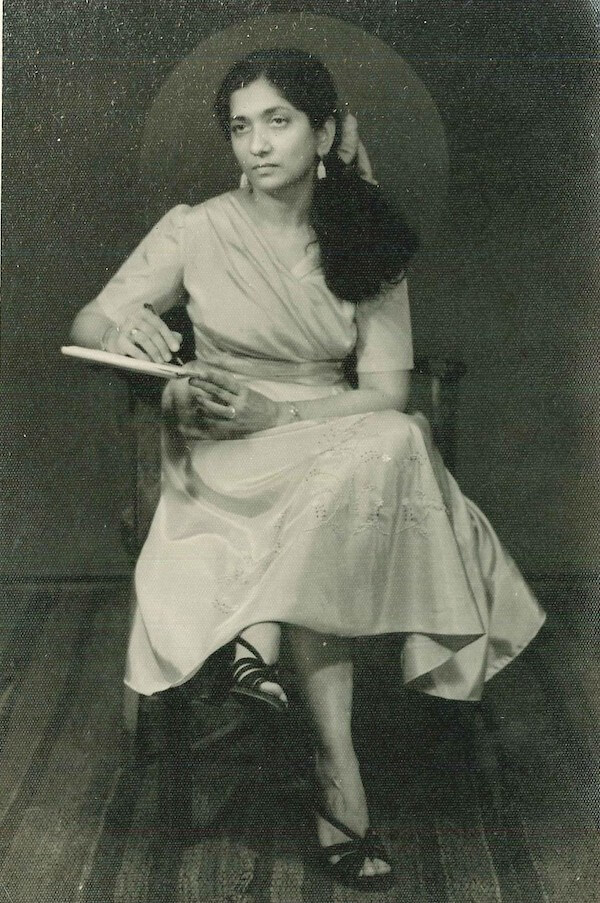
Photo 27
Tajbibi, studio photo, Mumbai, early 1960 (age 34). I and my siblings had traveled with her to Mumbai to visit her parents. Sadness is written all over her face, in her eyes, on her lips. Abualy Collection.
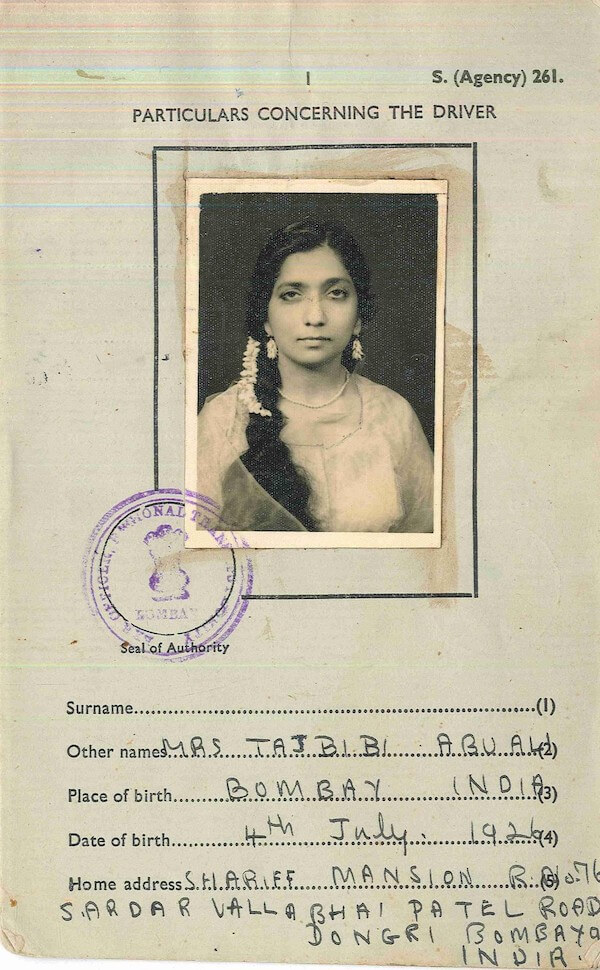
Photo 28
Photo of Tajbibi on her international driver's license obtained in Mumbai, 1960. I and my siblings had accompanied her to Mumbai. Abualy Collection.
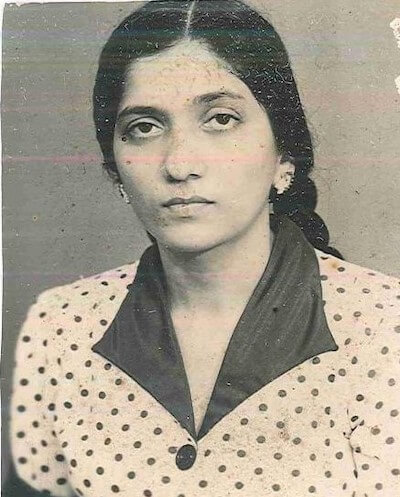
Photo 29
Tajbibi 1950s. Abualy Collection.
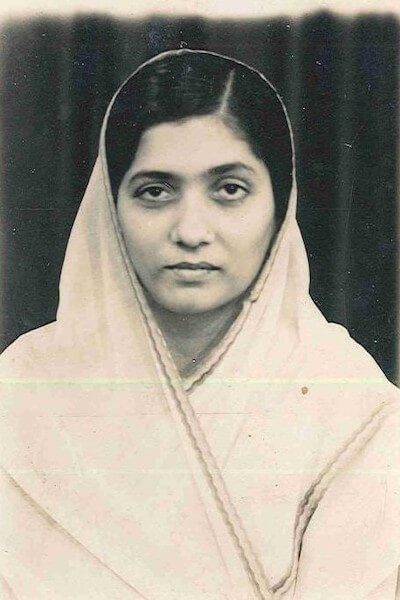
Photo 30
Tajbibi 1940s. Abualy Collection.
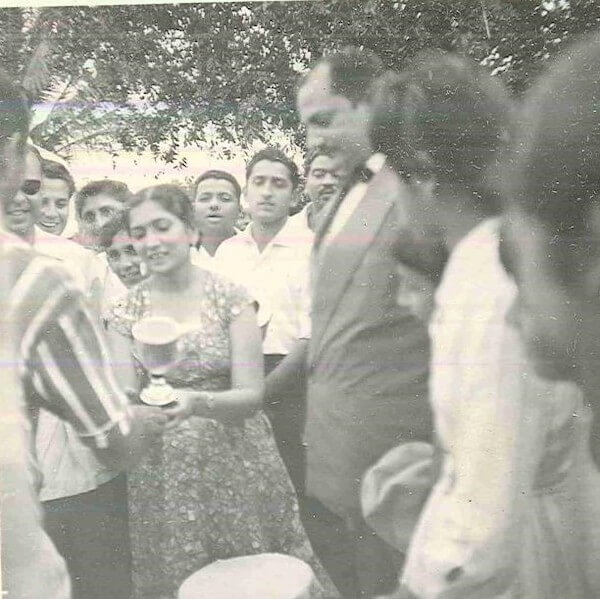
Photo 31
Occasionally Tajbibi accompanied Alwaez Abualy on his Waez tours. Here she is presenting a sports trophy in Laurenco Marques (renamed in 1976 to Maputo), Mozambique, late 1950s. Abualy Collection.
My Physics Teacher Mr Khan's Fateful Role
Tajbibi was so weighed down by her household duties following on her teaching duties at school that she could not devote time to raise her young sons or to monitor how they were doing at school. Alwaez Abualy was constantly away on his Waez duties, sometimes for stretches of nine months at a time. He was a very strict disciplinarian and would ban me from sports as punishment for some misconduct. So when he was away, I ran loose and became a discipline problem at school. My academic performance was very poor, failing in some subjects and barely passing in other subjects. I was especially poor in science subjects. The only subject in which I did well was "English Composition" (writing essays).
I somehow stumbled into Form III (Grade 11), which taught the first year of the two-year O-Level curriculum and textbooks developed by the University of Cambridge. The final exams at the end of Grade 12 were administered by the Colonial Office in London, Britain. The questions for each subject were set by anonymous teachers at British schools. These exam questions were flown from London to all the colonies around the world. Hundreds of thousands of Grade 12 students—from Nigeria through East Africa to India, Pakistan, Australia, Malaysia, etc.—faced the same questions. The answers of each student were flown back to London where British teachers graded them.
Students would not know their grades for the next three months, until March of the following year. And how would they find out what grades they had received? From the local daily newspaper. The British government would send the results to the Ministry of Education of each country. The Ministry of Education would then forward the results to the leading newspaper in the capital. Students would learn their fate by reading the paper.
The Grade 12 exams were a terrifying prospect for the students, except for the geniuses in every country who were on top of their material and looked forward to the exams. I was not one of these geniuses. I was busy with cricket, tennis, athletics and other sports and had not registered the danger awaiting me in Grade 12. My mother, on the other hand, became alarmed at my complete lack of interest in my studies.
One day at school, just as we had begun our Form III (Grade 11) year in January 1961, one of my fellow students sitting next to me shook me and whispered in a concerned tone, Mohamed, tāri mummy āyvi chhe! [Mohamed, your mother has come!] I looked up and saw that my mother had entered the classroom and was speaking with our class teacher, Mr Khan, who was also our physics teacher. All eyes were on me, wondering why she had come. I too wondered why she had come. Her presence was a complete surprise to me.
After a few minutes, she left the classroom. Mr Khan turned to me and said, Abualy, get your things and come and sit here. I had been sitting at the back among the rowdies, gundas, as they were known. He pointed to a desk in the front row, directly in front of him. He then shuffled some students to make sure that the better performing students were not harmed by being moved back to sit among the rowdies. Later at home that day I asked her why she had come and spoken with Mr Khan. She would only say, Teri bhalāi ke liye, "For you own good."
This short—a mere five minutes—but desperate intervention by my mother would prove to be the turning-point in my academic life. Mr Khan was one of the male teachers (along with Mr Carvalho, Mr Almeida, Mr Shaw, Mr Kabir, Mr Rehman and the English principal, Mr Gregory) who treated my mother with immense brotherly affection (she was the only female teacher in school at the time, although two English women later joined the school). These teachers had learned through their internal grapevine that she was living a very hard, overburdened and stressful life at home, so they were always very caring, solicitous and protective of her.
Mr Khan now began to focus on me. He would ask me to come to the blackboard and solve this or that physics problem in front of the class—Newton's laws of motion, Ohm's Law, resolution of forces, and so on. This strategy had its desired effect: I was one of two boys in my class to achieve First Division in the global Form IV (Grade 12) exams two years later, a result that launched me on my academic career.
Today, when I look at the photo of my mother in the staff room of the Aga Khan Boys' Secondary School (Photo 23), I feel myself succumbing to the temptation of discerning in my mother's intervention a teleological motive. I look at her eyes in the photo and see them looking directly at me, meeting my eyes, and I feel as though she was addressing me then and saying to me,
Beta [Son], a day will come when you will have to care for me, but you are not spending time on your studies. I am worried. How will you care for me in my old age if you fail Form IV?
Today, as I look at that face and those eyes through this teleological lens, I understand why she came to my class and spoke to Mr Khan: She was desperately seeking a way to get me to become serious about my studies, to ensure that I would pass the dreaded Form IV exams and set myself on the long path to academic success and financial self-sufficiency. And that is how her life and my life unfolded: our paths reunited after the death of my father in 2008, when I quit my job in the US and moved to Vancouver to live with her.
Mr Khan—a Sunni Muslim—occupies a special place in my heart for responding to my mother's pleas to him and for yanking me out of the dead-end I was headed toward, and for steering me toward a love for physics and scholarship. After I passed Form IV and entered Form V, Mr Khan continued his physics teaching into Forms V and VI [I went on to earn a double honors degree in physics and mathematics from the University of Dar es Salaam]. The sciences had become for me a solid foundation upon which I was able to build a successful career in several professions.
Mulāqāt with Mata Salamat and Hazar Imam; Visit with Mir of Hunza
Tajbibi and Alwaez Abualy regarded their visits to Mata Salamat, Hazar Imam and the Mir of Hunza as the most memorable and most precious of all their travels.
For Tajbibi, the year 1963 was a watershed year, for it marked the end of the years of suffering and various forms of hardship that had weighed down her spirit and left an unmistakable trace of sadness in her eyes and on her face. More than anything else, the warmth and grace shown by Mata Salamat to Tajbibi, and the blessings bestowed on her by Hazar Imam, buoyed her spirits and gave her the strength to continue to serve the Imam and Jamat.
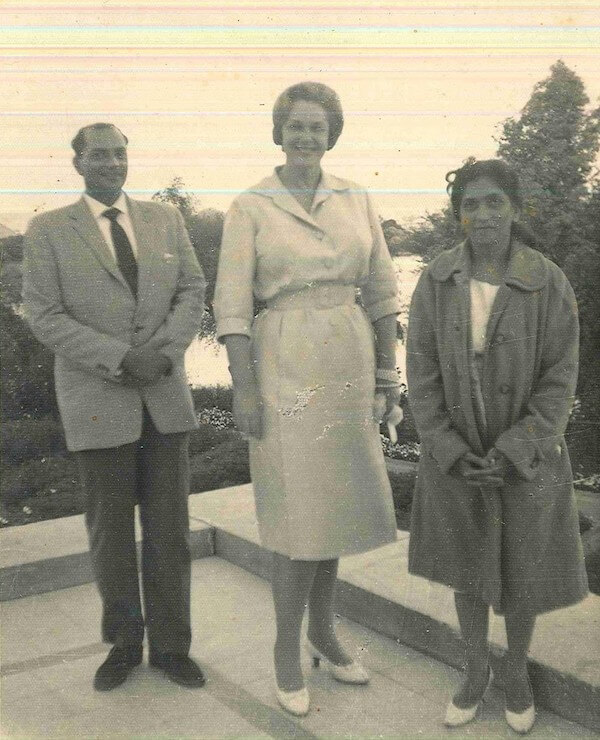
Photo 32
Tajbibi and Alwaez Abualy with Mata Salamat Om Habibeh Aga Khan in Aswan, Egypt, 1963. Alwaez Abualy had attended the funeral of Imam Sultan Mohamed Shah in July 1957. Upon his return to Dar es Salaam, he began a correspondence with Mata Salamat for some years. Unfailingly and promptly, and in her own handwriting, Mata Salamat always wrote back graciously and affectionately to Alwaez Abualy. Abualy Collection.
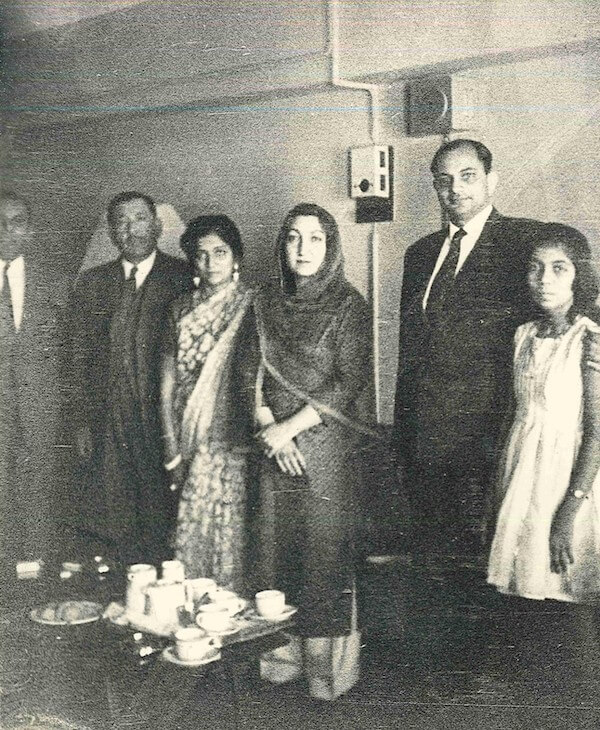
Photo 33
Tajbibi and Alwaez Abualy with the Mir of Hunza and his family (1963). The Mir and Begum were warm and gracious hosts to Tajbibi and Alwaez Abualy. Abualy Collection.
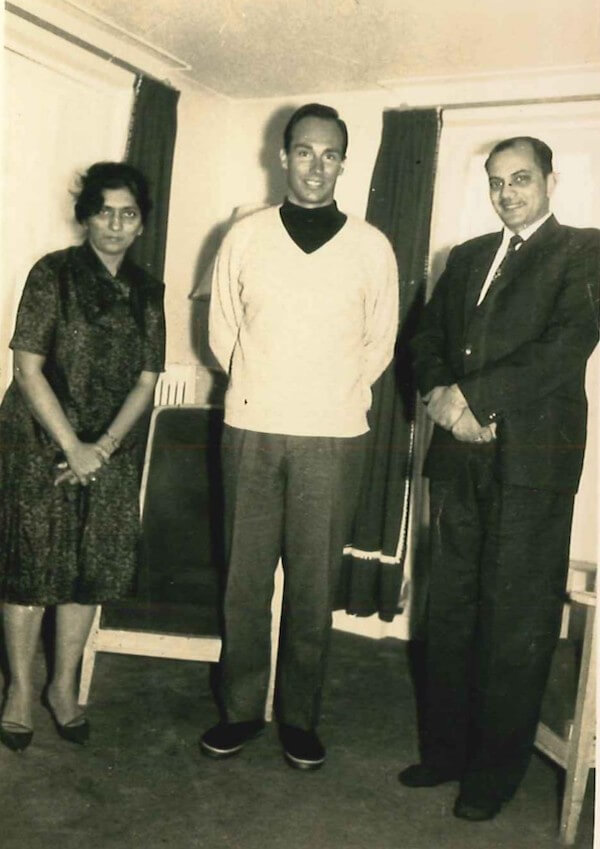
Photo 34
A photo to top all other photos in the Abualy Collection. Alwaez Abualy was on a Waez tour of the UK Jamat in 1963. He and Tajbibi were blessed to have been able to have a Mulaqat with Hazar Imam at his Gstaad (Switzerland) residence. Abualy Collection.
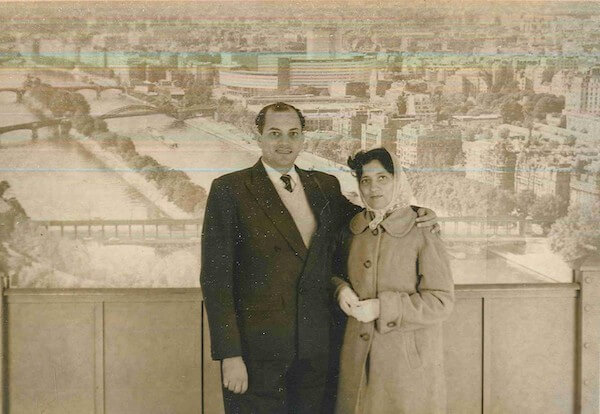
Photo 35
Tajbibi and Alwaez Abualy on the second floor of the Eiffel Tower, Paris, 1963. Abualy Collection.
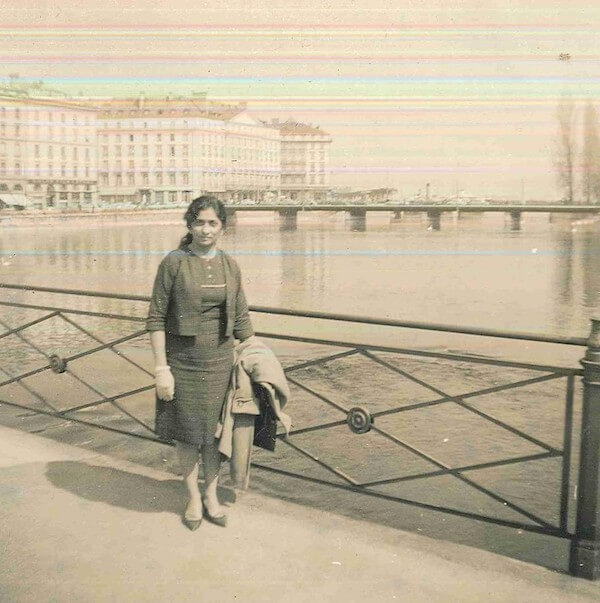
Photo 36
Tajbibi on the bridge over the River Rhone in Geneva, Switzerland. 1963. Abualy Collection.
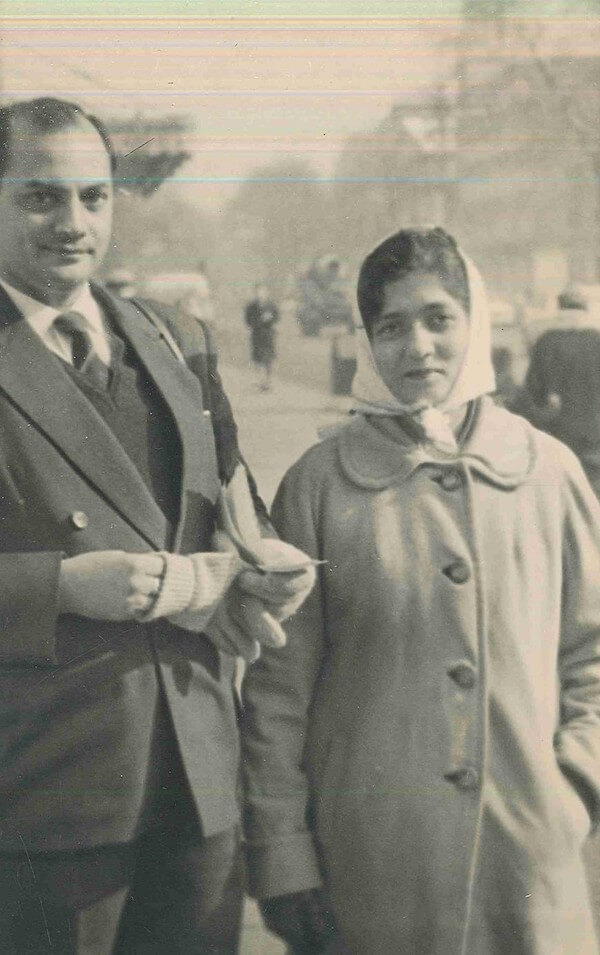
Photo 37
Tajbibi and Alwaez Abualy in Brussels, Belgium. 1963. Abualy Collection.
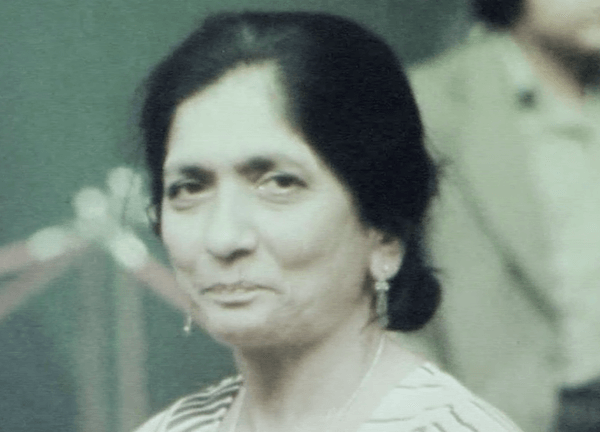
Photo 38
Tajbibi in London, 1979. Courtesy Lord Amir Bhatia.
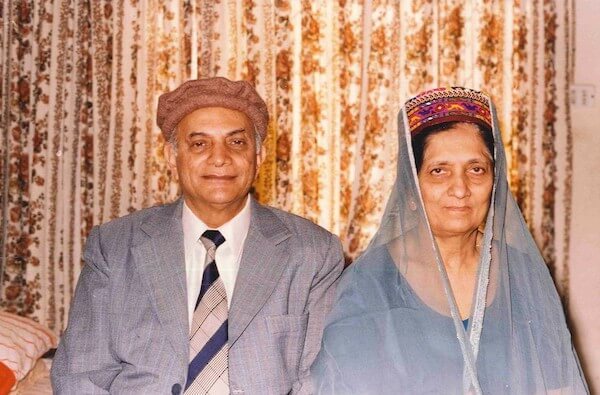
Photo 39
Tajbibi and Alwaez Abualy in Hunza, 1991. Abualy Collection
Member of the Library Committee, Upanga Jamatkhana, Dar es Salaam
One of Tajbibi's volunteering activities was her appointment to the Library Committee of the Upanga Jamatkhana. (Every Jamatkhana in the world has a library. It is a rare Jamatkhana that does not have a library.) She served on the committee in the 1960s.
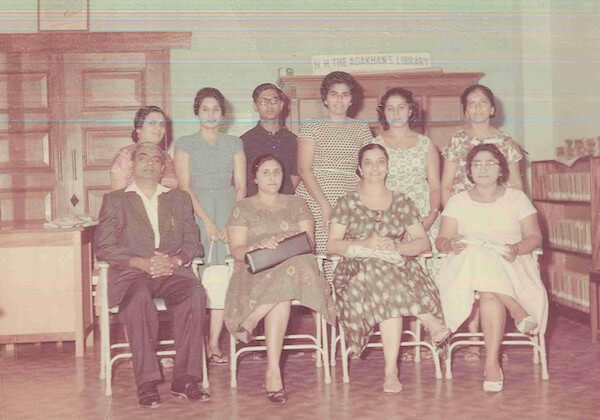
Photo 40
Tajbibi (standing, far right) with members of the Library Committee, Upanga Jamatkhana, Dar es Salaam, 1965. The young man standing at the back is Issa Shivji, who would go on to become a famous law professor at the University of Dar es Salaam and teacher to generations of future government officials in Tanzania. Issa became an internationally acclaimed professor and intellectual advocating for poor people everywhere. He was the inaugural incumbent of the Mwalimu Julius Nyerere Chair in Pan African Studies at the University of Dar es Salaam. Today he is Director of the Nyerere Resource Centre under the Tanzania Commission for Science and Technology, Government of Tanzania. (A thank you to Issa for the helpful details.) Abualy Collection.
Tajbibi in Canada
Migration to Canada in 1985 dramatically improved Tajbibi's life. The Jamat in Vancouver includes Kenyans and Ugandans alongside the Tanzanians. Tajbibi was revered as Missionary Ma, and at the Jamatkhanas, especially at Darkhana in Burnaby, she was showered with much respect and affection even by young girls.
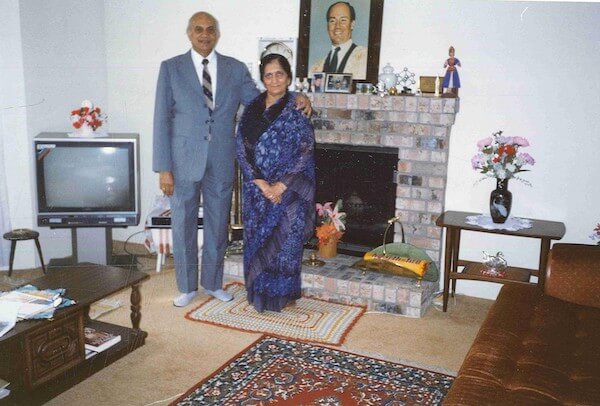
Photo 41
Tajbibi and Alwaez Abualy in their new and only home in Burnaby, British Columbia, soon after arriving in Canada in 1985. Their home became a pilgrimage site for members of the Jamat who came to seek counsel and guidance in spiritual and worldly matters from Alwaez Abualy. Abualy Collection.
Alwaez Abualy embarked on Waez tours around the world, most frequently to the Jamats in the US. But he also traveled to Tajikistan, India and Pakistan, where he delivered many Waezes to overflow congregations. Tajbibi accompanied her husband on most of these tours. The affection and respect the Jamats bestowed upon her buoyed her weary soul.
The Abualy residence in Burnaby became a pilgrimage site where individuals or families would visit Alwaez Abualy for counsel on a wide range of problems. Tajbibi played hostess to these visitors, serving them tea and cookies. In some cases the visitors would be treated to a meal prepared by Tajbibi.
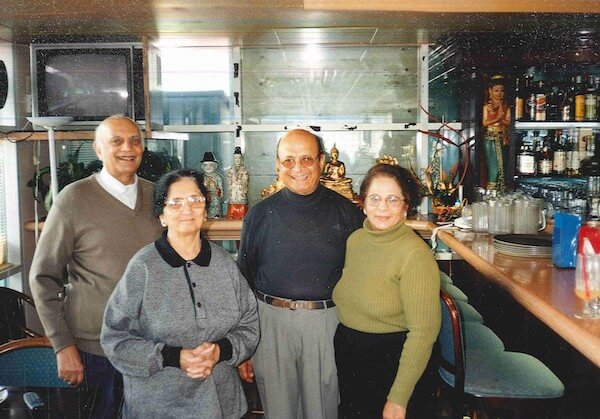
Photo 42
Tajbibi and Alwaez Abualy at the home of Alwaez Sultanali Nazarali Walji and Alwaeza Gulshan Sultanali Nazarali Walji in West Vancouver, British Columbia, 1990s. Alwaez Sultanali and Alwaeza Gushan had been Waezeen students of Alwaez Abualy at the Ismailia Mission Centre in Dar es Salaam. In Photo 14 Alwaez Sultanali is seen sitting on the ground next to me. He retained a lifelong affection for me. Alwaeza Gulshan also appears in Photo 14 (see the caption under Photo 14). Abualy Collection.
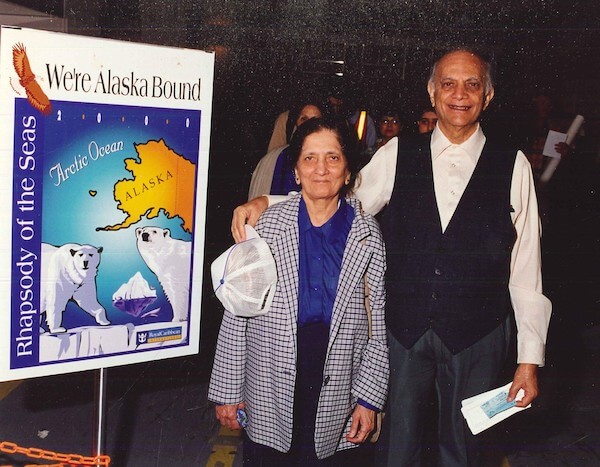
Photo 43
Tajbibi and Alwaez Abualy aboard a cruise liner to Alaska in July 2000. Canada had become a source of spiritual regeneration for Tajbibi after the hardships she had faced in Dar es Salaam. One of her in-law abusers had also moved to Vancouver. He would visit his brother but ignore Tajbibi, who served him tea and cookies and even cooked lunch for him. She resented his visits but she was no longer afraid of him. Outings such as this Alaska trip, and accompanying Alwaez Abualy on his Waez tours across Canada and the US, offered her an antidote to his unwelcome visits. Abualy Collection.
Tajbibi Becomes a Widow
Alwaez Abualy passed away in May 2008. I moved to Burnaby to live with my mother (my younger brother Hasan, who was living in Edmonton, Alberta at the time, joined us a year later).
Earlier in this essay, I described my father as a Ram-like figure for whom loyalty to his family, especially to his mother, and loyalty to tradition (Imam and Jamat) were more important than his obligations to his wife, especially his obligation to protect her from abuse by his family. But the analogy is not exact. It needs to be nuanced and placed in context.
My father had been a very difficult man to live with for my mother. He too, like the others in his family, had a very bad temper. So did his father (my grandfather), who was an Alwaez and delivered fiery jeremiads in Upanga Jamatkhana, which I used to attend. At home I and my two brothers studiously avoided interacting with or inadvertently running into the in-laws or into our grandfather.
Alwaez Abualy's missionary vocation greatly exacerbated his mistreatment of my mother. He was the only Alwaez in Dar es Salaam—indeed, in the entire African Ismaili diaspora—who was sent out on waez tours deep into remote Ismaili communities (many less than 10 families in size), to the islands of Zanzibar and Kilwa, to Kenya, Uganda and as far as Zambia, Zimbabwe, Madagascar, Malawi, South Africa, Rwanda, Burundi, and the Congo. There were times when he would be gone on these missions for eight or nine months. Whether in his waezes in Dar es Salaam or during his waez tours, Alwaez Abualy invariably said something about the Ginans or our Pirs to which the Ismailia Association or the Council took exception and punished him by suspending him from his Waez duties and docking his pay, or by simply stopping his monthly allowance.
Suspensions without pay and nonpayment of allowance were a frequent occurrence for my father starting in the late 40s and continuing all the way into the late 60s. He told me on several occasions, as he did to others who were close to him, that when Imam Sultan Mohamed Shah appointed him director of the newly established Ismailia Mission Centre in Dar es Salaam, he sent him off with words of encouragement: "Speak the truth. Do not be afraid of anyone. My hand is over your head." [Haqq bolnā. Kisi se darnā mat. Hamārā hāth tumhāre sar par hai.] He took these words to heart and committed himself to a life of an independent-minded Alwaez who spoke his own mind and who refused to be a mouthpiece for anyone else.
I must mention one very humiliating consequence of these suspensions that my father bore with immense dignity and silence. The German-era dilapidated bungalow in which we moved had been purchased by a very prominent individual in the Dar es Salaam Jamat. He was a Count and, after he died, his elder son received the title. When the institutions suspended my father without pay, he could not pay the rent. The Count had tolerated nonpayment of rent before, but his patience had run out. He demanded his rent even though he knew that my father did not have the money for it.
One day, as I and my brothers returned home from school, we were shocked to find the family belongings lying under the mango tree. The Count had come with some men, had broken into the house (both parents were away from home), had tossed everything out and locked the house. My father had to seek the intervention of community leaders and respected elders to persuade the landlord to allow us to enter the house. We had to call on our friends in the neighborhood to help move the belongings back into the house.
A few days later, as we were having dinner after returning from Upanga Jamatkhana, we heard the honk of a car. "Go see who it is," my father ordered me. When I stepped out of the house, I saw that the landlord's wife, Countess Ma, had come in her chauffeur-driven Peugeot 404 (this model, 404, was at the time the most popular car in the city). "Where is your father?" she asked me, her voice full of anger. I told her we were having dinner. She told me to tell him to come out. I went back in and came back out with my father.
The moment the Countess saw my father, she launched into a tirade, telling him what a scoundrel he was for not paying the rent, what a hypocrite he was for preaching one thing but not practicing it, what an irresponsible father he was for not taking care of his family, and on and on. My father responded the way he had when our Swahili Mama—as I have recounted above—had scolded him for hitting me: he lowered his gaze and stood in silence. She went on for what seemed to me a long time, until she got tired and suddenly turned, got into her car and drove off. After we returned to the dinner table, my father said to us, "I am the Imam's servant. These things have happened to me and will happen to me in the future. I don't want any of you complaining about her. Now eat your food." To my mother, this incident was just one more, if extreme, humiliation of her husband who refused to waver in his 24/7 dedication to the Imam and Jamat.
The Count's fortunes took a dramatic turn when the Aga Khan Hospital decided to build an extension wing. The hospital was situated right behind his bungalow by the ocean in Upanga. They wanted to build it on land that constituted the Count's back yard. They approached him and were successful in buying the back yard plot from him. The Count then had a change of heart and decided that he did not want to sell it after all. The hospital management did not want to relinquish the property. The Count then filed a lawsuit, which he lost. He lost all his money fighting and losing the court case.
Desperate for a source of income, he sought employment with some Ismaili businesses. But the Jamat had turned against him for having taken the Aga Khan Hospital to court. No one would give him a job. Finally, he came to my father and asked him to speak with some Ismaili businessmen about giving him a job. My father promised to help him. He spoke to some businessmen and said to them, "He is a Count. You must not humiliate him. Give him some job." An Ismaili store on Acacia Avenue (today, Zamora Avenue) hired the Count as their loading and unloading employee. His job was to drive the grey Peugeot 203—the 203 was the earliest model—pickup truck to load and unload merchandise. I would occasionally see him on Acacia Avenue in the afternoons (after school): he always wore a tie, as a reminder, so I thought, to himself that he was still a Count and should conduct himself with dignity even as a pickup driver. I found myself feeling sympathy for him, and I was very proud of the way my father had come to his aid and had safeguarded his dignity and kept him from being humiliated.
Our institutions in those days—the Councils and Ismailia Associations—reflected Indian culture's norm of collective punishment—all were, after all, staffed and run by settler Khoja Ismailis from (pre-Partition) India. When they suspended my father from delivering waezes, they also stopped his monthly allowance. My father was not a financially wealthy or independent man. He had dedicated all his life, 24 hours a day, 7 days a week, to serve the Imam and the Jamat. All sorts of visitors—some from remote towns in the country—used to show up unannounced throughout the day (and sometimes even during evenings), seeking advice from him on a wide variety of problems, including health problems (he was well-versed in Ayurvedic, Yunani30Yūnānī is an Arabic form of Ionia, which is located on the east coast of present-day Turkey. The first Greek philosophers, the Pre-Socratics—were Ionians. The medical tradition is based on the teachings of the Greek physicians Hippocrates and Galen. (Greek) and Prophetic (ṭibb-i nabawī) traditional medicines). Alwaez Abualy unfailingly and patiently, without a hint of his anger at being humiliated by the institutions, listened attentively to them before offering his counsel.
On other occasions, the institutions acted punitively and stopped his monthly allowance as punishment for his outspoken style. They did not stop him from delivering waezes; they simply stopped his allowance. The year 1966 was one of the hardest for our family because my mother had retired from her teaching career, bringing to an end her stable and regular income. That year, for a period extending five months, my father did not receive his monthly allowance. Finally, after repeated failures at receiving any response to his letters, in November he wrote to the Aga Khan Executive Council for Africa complaining of his mistreatment:
Is this the revenge you are taking from a humble missionary of Mowlana Hazar Imam, for his outspokenness, and for his weakness? First you humiliated me and now you are ignoring me so that I may starve with my family of 6 persons. This is not the first time that you have stopped my Allowance for months and months.45When even this letter failed to elicit a response, he became desperate about the welfare of his family and wrote a letter to Hazar Imam complaining about not being paid his allowance. Both letters, one to the Executive Council, the other to the Imam, are part of the Abualy Collection. [November 23, 1966]
Over a period stretching beyond twenty years, the institutions, in their deliberations, never gave a fleeting moment's thought to the damaging impact that my father's loss of income would have on his family. They had translated their personal animus toward him into a spiteful institutional policy. Consequently, we found ourselves depending on my mother's salary, which was not sufficient to cover all the expenses of the household. (As I have mentioned above, my mother had retired by 1966 so that we were no longer able to subsist on her income.) There was never enough food in the house. During exam time, when I would stay up late studying for the exams, I would find my father scrounging like a homeless man in the kitchen or searching in the fridge for some morsel of food. Like the rest of us, he too was hungry during these suspensions and pay stoppages. And yet, rather than abandon his ideas and transform himself into an ideological mouthpiece of the institutions, he upheld his independence by reminding himself of the words of Imam Sultan Mohamed Shah, regardless of the impact this stance had on his wife and children.
My father, ever the complete life-sacrificing devotee of the Imam, did not let the dire financial situation into which the punitive actions of the institutions had thrown him affect his policy toward delivering waezes. He was not a modern "professional" with a "No Pay, No Play" policy governing his "career." He continued to deliver waezes during this period even as he and his family starved. Waezes in those days were the prerogative of the Mukhi Kamadias. He never turned down a request from them to deliver a waez to their Jamats.
These suspensions and holding back his allowance took a toll on him. How could they not? And they forced upon him a tormenting contradiction: In his waezes he would speak of the responsibility of men to support their families. He would excoriate men who absconded from their duties to their families. Yet here he was, unable to discharge these duties in his own case. He knew that he should be the provider for his family, yet he was failing to do so. Nor would he talk about these matters with anyone. He regarded himself as the "Imam's servant" who had accepted that a life of service to the Imam would inevitably bring hardships upon himself and his family. He kept these feelings all to himself. He was already a short-tempered man, so it was only a matter of time before my mother or I became targets of his bottled up anger.
My mother, of course, was unhappy at not just my father's harsh words for her, but also at the whole situation in which the family found itself. She herself was the daughter of a travelling missionary in India and understood the pressures her father had had to endure as he traveled to distant places like New Delhi to deliver waezes. [The late Alwaez Amirali Amlani of Vancouver was his student and would accompany him on his waez tours (before migrating to Kenya in the early 1950s), as did the young Untouchable adopted boy, Kaderali Patel.] She was proud to be the daughter of a senior and much loved Alwaez in the Mumbai Jamat, and she was doubly proud and also deeply honored at being the sister of Missionary Kaderali Patel, whom Imam Sultan Mohamed Shah appointed as religion teacher in Nairobi for Princes Karim (Hazar Imam) and Amyn Mohamed. Much as she resented being at the receiving end of his temper and harsh words, especially considering the fact that she was the de facto bread winner in the house, she was able to absorb and endure these unpleasant interactions with him because deep down she fully supported his vocation as a dedicated Alwaez and servant of the Imam.
Throughout these years of ordeal and humiliating hardships for my parents, none of the in-laws, all of whom now enjoyed vastly superior financial wellbeing—one of whom had already become a millionaire—extended a helping hand to my parents. They were beneficiaries of my mother's sacrifices—her wedding jewelry, income from teaching, and slave-like catering to their everyday needs during their time in the Abualy household. She was of course bitter about this cold-hearted indifference from her in-laws, but, Sita-like, she suffered in silence and bore the brunt of the Executive Council's decision.
My father was not unmindful of the psychological injuries to my mother of his failure to bring in a steady income. Years later, as he lay dying at Burnaby General Hospital, my mother and I were alone with him one day. He spoke of returning home soon and resuming his projects on the Ginans. Even at his age and with his growing physical weakness, he would stay up till 1:00 AM in the library. Suddenly he became quiet. Then he turned toward my mother, joined his two palms together and said, "Taju, I did not treat you well. I have inflicted much hardship on you. Please forgive me [Tun muje māf kar de]." He did not make any excuses for his behavior. My poor beloved mother was completely unprepared for these words, for they ran counter to the dynamic that had governed their relationship all their lives. She broke down crying at these words and implored him not to say them.
For deep in her heart she understood—and as I have come to understand—that the life of a traveling missionary comes at a cost: he cannot but end up ignoring his duties to his family.31The "travelling missionary" problem has permeated the lives of the Jamat’s institutional leaders today. Many of them undertake multiple travel duties that take them away from their families. In other, more common, cases, they continue to reside in their homes but because they put in “ungodly” hours—60, 80 or more—on top of their 40-hour week in their professions or work, they become “absentee” husbands or wives or partners while still living in the house. Thankfully for them, they typically serve one three-year term (sometimes renewed to a second term), and they are all financially stable. My father, in contrast, was a lifelong 24/7 Alwaez with no independent financial base. Hazar Imam has shown great concern at the hardships these institutional duties have created for spouses and children. This inevitability is built into the structural logic of the vocation of the travelling missionary. My father's whole life, from the age of 14, when he started preaching, to his final breath at age 89, was given over in service to the Imam and Jamat. His wife and children came second. My mother understood this well. She was, herself, the daughter of a travelling missionary and a sister to another travelling missionary (Kaderali Patel). She could not but respect, admire and honor her husband's total and uncompromising dedication to the Imam and the Jamat even as she bore the brunt of its consequences. This was also true of Sita as the wife of the divine Ram: he too had mistreated her, but Sita understood the higher cause to which Ram had dedicated himself and had willingly accepted her fate, namely, that she had to come second to Ram's primary commitment to his higher mission.
After the passing of Alwaez Abualy, my mother stopped attending Jamatkhana except for the monthly Mubarak Majlis; this practice too, she eventually stopped as she grew very weak. She established a daily routine for herself. Her day always began with a sip of Niyaz (water blessed by the Imam), followed by tea and toast. She would then sit on her bed and pray for an hour or so. She kept a copy of Anant Akhādo32"Anant akhādo" is generally understood within the Jamat to mean "a gathering of an infinite number of souls." The 500-verse Granth (a very long composition) is attributed to Pir Hasan Kabirdin. by her bedside, along with some handwritten Ginans that she was fond of. She would recite "Ya Ali" all the time with her tasbih, including when she paced back and forth in the house, and even as she stood by the window of the living room and looked out at the street and the neighboring homes.
Bollywood Hindi Films
Hindi films were not just a major source of entertainment for the settler Indian33For the purposes of convenience, I am using “India” and “Indian” as a group label for the Indian, Pakistani and Sri Lankan settler communities in these parts of Africa. (Wahindi) communities in East, Central and Southern Africa. Nor were they just a continuing link with the mother country (India) and its culture. Hindi films of the 40s, 50s and 60s—the Oldies Goldies years—were morality tales whose plots and characters were modelled on plots and characters drawn from the two great epics, Mahābhārata and Rāmāyana. And just as we see in these two epics, the Hindi films were always about families, sometimes a single family facing the destructive schemes and actions of an evil man, or a struggle between two families that were eventually reconciled by the romance between the boy from one family and the girl from the other family.
The romances in these Oldies Goldies films were between two hearts (dil), between two souls (ātmā). They had not yet been replaced by a physicalist and sexualist conception of love borrowed from Hollywood, a trend that began in the 70s and is now a staple of the contemporary Hindi film. Still, dil-based ātmic love continues to find place in the modern Hindi film—as the blockbuster films Veer Zara and Devdas show—but those who grew up during the decades of the Oldies Goldies do not like the "taste" of most of these modern films.
Not just romance, but human relations depicted in the Oldies Goldies films presupposed a body-soul dualist conception of the human being. In this conception, the ethics that governed human relations were rooted in and sprang from the heart (dil) or soul (ātmā). The hero or heroine were not just two hearts attracted to each other; they were two hearts whose thoughts and actions were morally good thoughts and actions. The heart (dil) was the seat of conscience that guided the morally good thoughts and actions of the hero and heroine.
The Indian communities in Africa were socially separate faith communities—Khoja Ismaili, Khoja Ithnashari, Sunni, Hindu, Sikh, Goan (Catholic), Bohra, Buddhist, and so on—but they all reproduced in one form or another the Indian sasurāl-bahu model of the family, and they all remained anchored, in their intra-communal social relations, on the dil/ātmā conception of the human being and ethics. Girls and young women in these communities may have been governed by the religious norms of their respective communities, but they were all bahus or destined to be bahus, and it was this bahu fate that became a powerful factor in drawing them to these films. The films could offer them cautionary tales about the miserable life that typically is the lot of the bahu who is unlucky to come under the authority of a domineering mother-in-law (sās).
A second major characteristic of these Hindi films is that they held up marriage as the outcome of a love relationship between the hero and heroine. The parents, representing tradition, were depicted as barriers to the lovers, whom they wished to marry someone else. Girls in the African Indian communities lived socially restricted lives. They married boys who were chosen by their parents. They dreamed of falling in love and marrying for love. The Oldies Goldies films portrayed their dreams on the screen. But whereas the lovers in the films eventually overcame their familial obstacles and got married, the Indian girls in Africa could only return home strengthened in their dreams but resigned to arranged marriages.
The Oldies Goldies films were deeply spiritual because the human relations they depicted were based on a dil/ātmā conception of the human constitution and ethics. Many films were overtly religious in their themes and plots. One of the first Hindi films was Raja Harishchandra (1913). Raja Harishchandra, his queen Tara Rani and their son Rohidas figure prominently in numerous Ginans.34Karim Tharani has designed the wonderful website Ginan Central at the University of Saskatchewan. It lists 91 occurrences of the word "harishchandra" in the Ginan corpus. Visit the website at http://ginans.usask.ca/concordance/entries.php?id=3949.
It was not just the spiritual and religious content of these films that attracted the Indian faith communities in Africa. The songs, their vocabulary and music (rāga) were the backbone of the story. The love depicted in these songs deployed religious vocabulary, and this religious vocabulary could toggle back and forth from referring to love between the dāsi (devotee) and God—human-God love—to love between man and woman—human-human love. Some of the songs were uncannily Ginan-like: for example, in the film Baiju Bāwrā (Baiju the Insane), the vocabulary and theme in the song (sung by the immortal Mohamed Rafi) Man tarpat hari darshan ko āj… (The soul craves to see my lord today…) could easily have come from some Ginan—the line in the song, Bin guru gyān kahān se pāun (Without the guru where will I seek knowledge?) expresses an idea central to Satpanth, that without the gurpir (Pirs) there is no spiritual knowledge jnān (ginan). [The word gyān in Mohamed Rafi's song and the word jnān have the same Sanskrit roots.]
The Film Mother India
I will present a fuller treatment of the intimate connection between Satpanth and the Oldies Goldies Hindi films in Part Three of my remembrance of my beloved mother. Here I wish to remark that for Tajbibi these films were an immense source of spiritual strength and a model for the kind of woman she should be.
The film that had the greatest impact on her was Mother India (1957), which many people, including me, regard as the greatest Hindi film. The plot of the film draws on the travails of Sita in Rāmāyāna. The attributes that Sita possessed and displayed in her exile are the attributes that Nargis—Rādhā in the film; I will continue to use "Nargis"—displays in her immortal and stupendous acting. Mother India presented Nargis as a Sita-like role model not just for Tajbibi but for countless girls and young women in India and the Indian diaspora in Africa and elsewhere.
The tormentor of Nargis is her moneylender. He is a heartless extortionist and predator who preys on her helplessness by demanding sexual favors, which she fends off. Her husband, played by Raj Kumar, loses both arms in an accident. Overcome with guilt at not being able to provide for his family and, instead, at having become a burden on his wife, he walks away one day, never to be seen again.
Her younger son, played by Sunil Dutt, adds to her woes because he is a dāku (gangster) who harasses the girls in the village but in reality loves one girl who, sadly for him, does not love him. I will spare the reader the heart-wrenching finale to Nargis's troubles with her younger son. Eventually, after years of unspeakable suffering that Nargis has gone through, she and her elder son (played by my mother's favorite actor, Rajendra Kumar) finally break out of poverty and succeed in owning a farm. In the ending scenes, as she is performing the opening ceremony of the irrigation canal, the film shows her standing at the head of the canal, almost leaning against Rajendra Kumar, her hair now streaked with white and her aged face contorted by creases, wrinkles and furrows that are the result and also the testimony of the abuses and sufferings she faced throughout her life. But the main reason why this scene and her face are so compelling and unforgettable is that there is no sparkle or joy in her eyes and lips, only sorrow and pain. Nargis could never bring back the sparkle in her eyes and smile to her lips that she lost during her years of torment.
When my mother watched this film, in the early 60s, her years of torment at the hands of her in-laws (the analogue of the cruel moneylender) were mostly behind her, just as they were behind for Nargis. But like Nargis, she could never bring the sparkle back to her eyes or the smile to her lips. Although she was a gracious host and would warm up when she visited her lady friends, once she returned home, she reverted to her beaten-down and wearied soul. Her face became covered with lines of sorrow, suffering and deep pain. She rarely laughed. [The photos I have presented here show this loss of sparkle and smile on her face.]
After I moved to Vancouver to live with her, she and I would watch Hindi films and the daily serials (soap operas) until her increasing weakness made it impossible for her to sit and watch them. Among the multi-year daily serials that we watched together were Kuch Toh Log Kahenge (People Will Talk; a favorite), Yeh Hai Mohabbatein (This is Love; also a favorite), Pavitra Rishta (Sacred Relationship), Diya Aur Batti Hum ([You are] the Lamp and I the Wick), and Dil Ki Nazar Se Khoobsurat (Beautiful in the Eyes of the Heart). The soaps have remained remarkably faithful to the Oldies Goldies conception of ātmic love that must fight its way through the minefield of obstructionist families and their quarrels.
We also watched the TV serialization of Mahābhārata (267 episodes) and Rāmāyana (52 episodes). In spite of her growing weakness, she made a great effort not to miss the episodes that involved Draupadi and Sita.
Reading Books
There was another positive aspect to Tajbibi's move to Canada: she was able to indulge in some serious reading. Almost to the end, she had no qualms about reading books that undergraduates would find daunting.
She read Oxford University scholar Faisal Devji's The Impossible Indian: Gandhi and the Temptation of Violence (2012) in three days and nights, sitting up in her bed reading late into the night, well past midnight. Similarly, she read Sultan Somjee's groundbreaking Bead Bai: Khotā Moti Nā Sāchā Wepāri (2013)35"Honest Trader of Fake Pearls." I will have more to say about Somjee’s book in Part III of my memorialization of my mother. in three days, and Sujata Massey's highly acclaimed historical fiction, The Widows of Malabar Hill (2018), in just 2 days.
Soccer: Manchester United
Our family was a sports family. As a young man in pre-Partition India, Alwaez Abualy was a top-flight (field) hockey player whose playing career ended when he was struck in his ankle by a hockey stick. Tajbibi liked playing badminton, but her domestic life prevented her from playing this sport. All the three boys played one or more sport. My two younger siblings settled on tennis as their preferred sport. I settled on cricket even though I loved playing football, tennis and athletics (sprint races, long jump and high jump).
But it was football that our family followed. The English first division (later replaced by the Premier League) was followed by all the Indian communities. The three English teams that had the largest following were Manchester United, Arsenal and Liverpool. In a recent visit to Dar es Salaam, I visited the Kariakoo section with an old friend who still lives in the city. We stepped into a small Swahili chai place and were surprised to find a life-sized photo of Michael Owen, the well-known Liverpool player, looking down on the patrons. The Abualy family was a solid Manchester United family.
In Vancouver, my mother and I would watch Premier League games on weekends and UEFA Champions League games at mid-day during weekdays. We watched the 2010, 2014 and 2018 men's World Cup. We were visited just before the 2018 World Cup by Dr Shelley Hawrychuk, the Chief Librarian of the University of Toronto Mississauga. Dr Hawrychuk knew of Tajbibi's interest in football. She brought a copy of the World Cup guidebook as a gift for Tajbibi. Both my mother and I relied on this guidebook to follow the games.
Memorably, she and I watched the semi-finals and finals of the Women's World Cup just a month before she passed away. [The games were played during June 7 to July 7, 2019.] She was astonished at the high quality of the women's game.

Photo 44
The Abualy family, along with many other Ismailis in East Africa, were supporters of the Premier League football team Manchester United. After settling in Canada, Tajbibi became a regular watcher of Premier League and European football games. She understood corner kicks, penalties, offsides (and offside traps!), yellow and red cards, etc. She made a list of the top players (her favorite was Cristiano Ronaldo), the managers (especially Sir Alex Ferguson of Manchester United), and even goalkeepers (above). Note the names: (Iker) Cassilla of Real Madrid, (Petr) Cech of Chelsea, (Pepe) Reina of Liverpool, and (Edwin) Van Der Saar of Manchester United. Abualy Collection.
Final Act: Gifting the Abualy Collection to the University of Toronto
Alwaez Abualy had painstakingly and lovingly built up an immense and unparalleled private collection of Ismaili literature (books, manuscripts, community magazines, community documents, and other categories of source material). After he passed away in 2008, Tajbibi assumed responsibility for it.

Photo 45
A view of Alwaez Abualy's library in the lower level of his home in Burnaby, British Columbia. The core Khojki literature was housed in an adjoining room. Alwaez Abualy had to place bookcases in the hallway outside the library to accommodate his large collection. Abualy Collection.

Photo 46
Alwaez Abualy in his library at his home in Burnaby, British Columbia, ca 1990s. Abualy Collection.
Her final major act on behalf of the long-term interests of the Jamat was her decision that the Jamat in Canada and worldwide, and the Canadian academic community, would be best served if the Abualy Collection were housed at the University of Toronto.
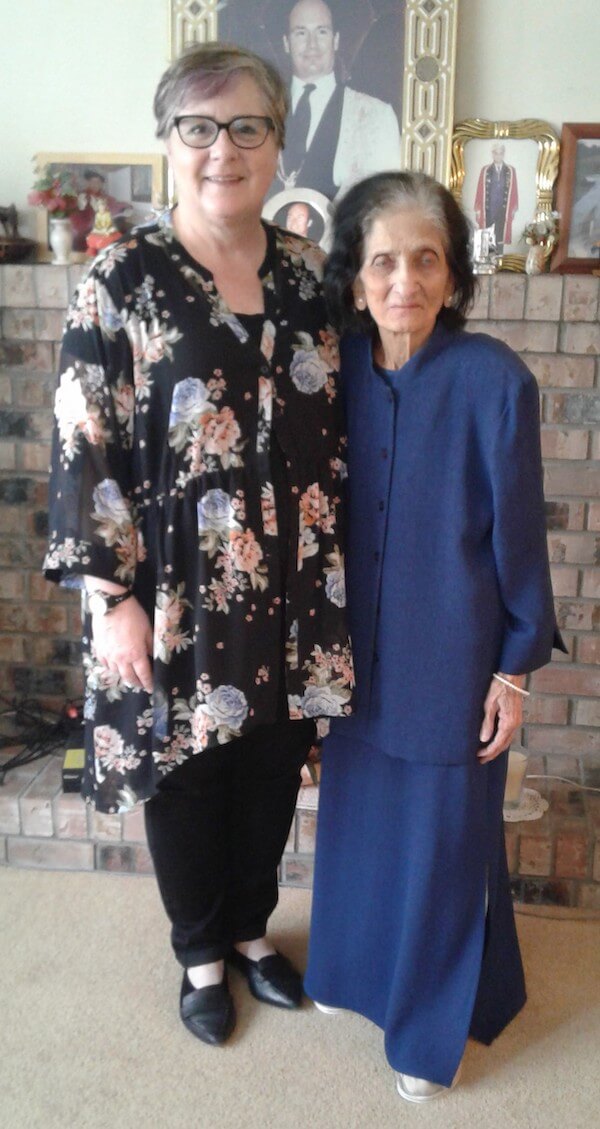
Photo 47
Tajbibi with Dr Shelley Hawrychuk, Chief Librarian, University of Toronto Mississauga, at her home in Burnaby, British Columbia. Photo by Mohamed Alibhai.
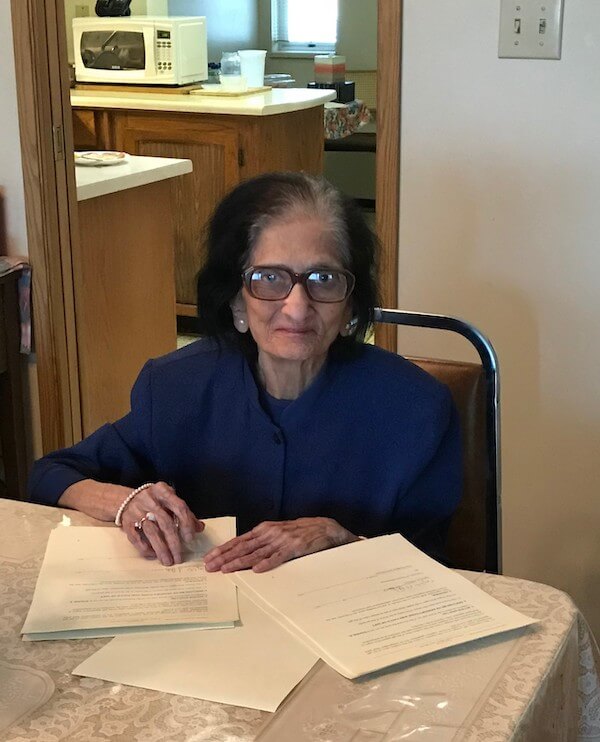
Photo 48
Tajbibi signing the Deed of Gift donating the Abualy Collection to the University of Toronto, 2018. She is sitting at the dining table in her home in Burnaby, British Columbia. The photo was taken by Dr Shelley Hawrychuk, Chief Librarian, University of Toronto Mississauga. Courtesy of Dr Hawrychuk.
A Satpanthi Till the End
Tajbibi loved the Ginans of Pir Imam Begum. On the day she passed, it was as though Imam Begum had penned the following words with Tajbibi's passing in mind:
Te din sāmi mune pās tedāvjo,
Pakadi lejo māro hāth36Verse 13 of the Ginan by Pir Imam Begum, Darshan diyo morā nāth, Dāsi chhun teri. Accessible at Karim Tharani’s web site, Ginan Central, http://ginans.usask.ca/commons/view/20210750.
On that day, Lord, summon me to you
[And] Take a hold of my hand
Epilogue
I began this remembrance of my mother with the Prologue, in which I addressed the young Ismaili women in the Euro-American countries. I noted that while she would have supported and applauded the unprecedented freedoms they enjoy in these countries, she would have wondered whether there was anything in common left between her and them other than the personal and private bond that she and they—indeed, all Ismailis—have with the Imam.
From the distillation of her life that I have presented in this essay, it would appear that, lamentably, there is very little that our young women will judge as relevant, let alone inspiring, to their own lives as Ismaili women. The freedoms they enjoy are legally protected freedoms, one of the great achievements of the American Civil Rights movement of 1964. The acceptance today by wider society of the right of the woman to an independent life, to control her own body, to move freely in society and economy without gender discrimination, and so on, have also strengthened their resolve and capability to “not put up” with any abuse in their marital life.
The family structure in the Euro-American Jamats has long moved past the sasurāl-bahu model toward the nuclear model that is now the norm in Euro-American societies.37I am, of course, referring to Indian-origin Ismailis, not to members of the Jamat from other Ismaili traditions (Tajik, Syrian, Afghani, etc.). Young Ismaili married women are no longer bahus in the traditional sense, physically moving into their husband's household and normatively coming under the control and authority of the mother-in-law (sās). The young couple establish their own residence at a different location and create a new nuclear family alongside, at peer level, with their respective parental nuclear families.38The nuclearization of the Ismaili family structure was greatly facilitated by Imam Sultan Mohamed Shah’s constitutional reforms, of which the disbandment of the Hindu dowry practice was one of the most consequential for the daughter-in-law’s relations with her in-laws, as well as for her own family, who were released from the crushing financial burden involved in having to marry their daughters. However, the sasurāl-bahu model is not only still the norm in Indian society, it has made a fierce resurgence within the very class that we would expect to have adopted progressive values: the upper and middle classes. The rise of the middle class has spawned a billion-dollar matrimonial match-making industry that brokers the family of the boy and the family of the girl. The boy’s mother visits a match-making company, which carries photos of thousands of girls. The mother surveys the photos and selects the one she likes. The company then arranges for the two families to meet. The middle classes have dramatically escalated the dowry they demand from the girl’s family. They typically draw up a long wish list that can include such items as a Honda and other expensive objects. If a wealthy family is involved, the boy’s family can demand that the girl’s father hand over half the ownership of his steel mill to the boy. In some cases the in-laws regard the dowry as an open-ended list, making additional demands after the couple have begun married life. Sons are “cash cows” for their families. They are valued more than daughters because they will bring in a bonanza when they are married. Daughters, on the other hand, are a financial drain on the family. The susurāl-bahu is already a microcosmic caste system predicated on the principle of inequality. The dowry component of this model introduces another form of inequality, that between brother and sister: the parents value the son more than they value their daughter. One of my South Indian coworkers during my IT career was married to a Tamil woman who had a BA in sociology. Yet her family had to come up with the US equivalent of $300,000 as dowry to fulfill the demands of her husband’s family.
Thus, in tandem with the cultural transformation of the Ismaili family, the social transformation (nuclear family, physical distance, economic independence, etc.) has greatly strengthened the capacity of the young Ismaili woman in Euro-American Jamats to fight back at any attempt by her husband or in-laws to mistreat her in any way. She no longer has to suffer, tolerate, put up with or otherwise bear any mistreatment from the husband or his family.
This willingness and capacity to fight rests on the institutional remedies within the Ismaili community and within the larger Euro-American political, social and legal systems. Within the Ismaili community, the aggrieved wife can seek assistance and resolution from the CABs (Conciliation and Arbitration Boards) and, more informally, from mukhiani and kamadianis (who then take the complaint to their husbands (mukhis and kamadias)) for practical advice. They may also seek support and guidance from their female friends (as happens with fellow Canadian and American women). The wider, external polity offers several institutional remedies and counselling services, including the option to seek a divorce and start life anew. There are no longer any stigmas or social ostracisms linked to the wife who complains about being mistreated by her husband or in-laws, or who seeks and secures divorce.
None of these remedies was available to my long-suffering mother and to women of her generation and previous generations in Africa and India. They were, in effect, trapped inside the sasurāl-bahu family structure: there was no escape from it. And just as the nuclearization of the Ismaili family today (and its associated social and legal remedies) is supported and justified by a corresponding cultural value system (autonomy, freedoms, economic self-sufficiency, empowerment, etc.), so the sasurāl-bahu family structure was buttressed, justified and perpetuated by the several mutually supporting religious and cultural components in Indian society (the caste system, Manu's Laws, Mahābhārata, Rāmāyana, etc.).
One major, if not the sole, reason why Sita became a universal "go to" personality for generations of Indian women, and why Sita is such a ubiquitous name for Indian women,39The eminent American scholar of Hinduism, Wendy Doniger, expresses puzzlement over the popularity of Sita rather than that of Draupadi. In expressing this puzzlement, Doniger has unwittingly betrayed her lack of understanding of the influence of the Hindu religion among ordinary Indians, not just among Hindus. There is no room in her conceptualization of Hinduism for someone like my mother, who was imbued with Sita’s life and its lessons for Indian women. Her single-minded focus on ideas—philosophical, religious, mythological, and so on—to the exclusion of an anthropology-like consideration of, say, the sasurāl-bahu family structure and culture, seals her off from understanding why Sita is a very popular name for girls in Indian society: it is because this family structure is ubiquitous in Indian society, and bahus are trapped in it. I will present a substantive critique of Doniger’s treatment of Hinduism in Part III of my memorialization of my mother. Wendy Doniger, The Hindus: An Alternative History (2009), p232 and p298. is that she is the "remedy" for the suffering bahu who is trapped inside the sasurāl-bahu family. There is no "exit" door for her, so the only realistic remedy is to build up the capacity for suffering the abuses from her husband or in-laws. Sita is the role model par excellence in Indian culture who shows women and girls how to suffer. All Indian girls are introduced to Sita in their young years, and they imbibe her moral attributes as they listen to or read her life story. That is what Tajbibi, my mother, did when she was growing up in 1930s India. Sita was an integral part of her Satpanth faith (as the Ginans testify), and explains why she saw in the character of Nargis in the film Mother India a powerful modern display of the role that Sita had defined for Indian women. Sita was, and remains for millions of Indian women today, the archetypal Mother India.
Even as I, along with my mother, applaud and support the remarkable achievements of young women in the Jamat, I cannot escape the emotion of lament that accompanies my positive emotions toward their achievements. For these advances made by my younger sisters have not been made without costs. The one cost that I have observed and felt in relation to my mother's life is that these advances in personal autonomy, remedies and escape doors that our young women enjoy today—and rightly enjoy them—have also rendered them impatient and deaf to the sufferings of women like my mother. There is a self-centred MeToo-ism engendered by these advances which evokes impatience, deafness and irritation toward the sufferings of Old School women like my mother. It is easy for me to imagine the young Ismaili woman saying, "You know, I wouldn't put up with it for one second! I'd be gone in a jiffy! Bye Bye!"40Again, I wish to remind the reader that these remarks are generalizations that admit of exceptions.
The outsize, deeply humane and feminist enlightenment of Imams Sultan Mohamed Shah and Shah Karim is unique among the world's religious traditions. A straightforward "sociology of religion" consideration of religious traditions provides us with an explanation for why they are universally disapproving of divorce: it is because all religious traditions are committed to perpetuating themselves down the generations. All of them view the mother as the "one-teacher BUI center" in the family, the locus of teaching their children the beliefs, values, norms and practices of their religious tradition. This "logic" of the continuity of religious traditions cannot but discourage divorce. Religions have also been strongholds of patriarchy and androcentric worldviews that men then marshal to assign women and mothers their "proper" role, which is to produce the next generation of the tradition's carriers.
These characteristics are very much still at play today among the numerous Abrahamic denominations in Canada and the US. They all view the mother as the main teacher of the faith to the children, and they all, even today, disapprove of divorce even as they accept it and, in some denominations, provide internal mechanisms for facilitating divorce. The Roman Catholic Church is one of the most inflexible with respect to divorce: it is almost impossible to secure one.
Another example is the Latter-Day Saints (Mormon) community, which I know well. While they are not as unbending as the Roman Catholic Church, they continue to regard women as the center of family religious education even as they allow women to acquire higher education and become professionals and join the workforce. In one of my IT projects, I joined an in-house team that was led by a Mormon woman. She knew that I had been married to a woman from a Mormon background, so she and I became close friends, she a dīn bahen to me, I a dīn bhāi to her (she would invite me to religious programs at the Temple). She eventually confided in me her domestic travails, and I realized that she was a Sita-type silently suffering wife whose alcoholic husband was abusive toward her and the children. And like Sita, she was (and still is) a very compassionate, pure-hearted and caring human being—and a very competent, professional and skillful software developer and systems analyst.
This brief survey of the Abrahamic religious traditions shows that the Sita-like entrapment of wives is more of a norm among them that an exception. The so-called Ultra-Orthodox Jews, the Hasidim, are among the strictest religious traditions in North America. The explosive revelatory account of Deborah Feldman, Unorthodox: The Scandalous Rejection of My Hasidic Roots (2012), can be construed by young Ismaili women as a sobering appreciation of the fact that their freedoms have been promoted by their supreme spiritual authority, the Imam.
It is one of the great ironies of inter-faith relations that because Sita, the paradigm of how to suffer as an entrapped wife in the Mahābhārata, is a product of Hindu beliefs and norms and is a "Hindu personality," she is denied universal relevance—for example, to women in the Abrahamic denominations—by secular-humanist Euro-American scholars of Hinduism. They view the status of women in Hinduism through the lens of their secular humanism and, comparing their own freedoms with the entrapped conditions of Hindu women, unconsciously filter out from their cognitive systems the notion that Sita might have some relevance to Canadian and American Jewish and Christian women who are trapped in a Sita-like marital situation.41I will elaborate on this point in Part Three of my remembrance of my mother through an extended discussion of the American scholar Wendy Doniger, widely regarded in academia as the foremost scholar of Hinduism not just in the US but in the world. Doniger dwells at length on the idea of the Indian woman as also an ogress whose archetypes are the women in the two epics. Thus Sita is an ogress waiting for the right moment to strike. Doniger’s policy of viewing Indian women as also ogresses is part of her policy—and that of her Euro-American colleagues—to regard the personalities of the women in the two epics as “Indian/Hindu” personalities who do not share their ogress side with Euro-American women. Does Doniger believe that she too is an ogress?
Even though Ismaili women are exceptional in being granted by the Imams the wide freedoms that they enjoy today, some of them may choose, for reasons that they find compelling, to remain in their intolerable situation and instead seek support and solution in prayer and supplications to the Imam, and in other religious practices of the Jamat, including volunteering.
To such women my mother can be a model and an inspiration. She sought strength, courage and refuge in Hazrat Ali (Imams Sultan Mohamed Shah and Shah Karim); and Sita supplemented these supplications to Hazrat Ali by teaching Indian women, through her own example, that the most effective practical way of making an intolerable situation tolerable is by setting aside these psychological cruelties and digging deep into one's soul (ātmā) and serving others with compassion, kindness, generosity and wise counsel. This was the secret of Sita's "how to" approach to her own cruel treatment by Ram42Both the great epics—Mahābhārata and Rāmāyana—have been viewed through the lens of gender among Indians. Whereas Krishna is adored by both men and women, this is not the case with Rām: he is a divine figure and object of worship by men but not to the same extent among women for whom Sita remains the supreme spiritual object of veneration. Gandhi was a devotee of Rām: the last words he uttered as he succumbed to the assassin’s bullet were “Hey Rām.” The Ginans, too, view Rām as a divine personality on a par with God, as in the line Ram aur rahmān donu ek ghusaiyān (Ram and Rahman both are one and the same.”). I will elaborate on this point in Part Three of the remembrance of my mother. and his family.
Earlier, I had lamented what I perceived is our young women's attitude toward their grandmothers and great grandmothers, namely, that these elders are irrelevant to their life as Ismaili women in the modern world. Would it be unjustifiably optimistic of me to hope that perhaps my mother's Satpanth faith, rooted in and drawing upon the nourishing spirituality of India's religious traditions reaching back to the Vedas, might prompt some young women to re-examine their attitude, and relations with, their grandmothers and great grandmothers who are either living with them or are living at extended care facilities?
These elderly women have their stories to tell about their Satpanth faith, the travails, tribulations and sufferings they encountered, faced and overcame, and the sacrifices they made, out of love for the Imam and Jamat, to lay the foundations of the settler Jamats in Africa and nurse the fledgling community to maturity. Sultan Somjee's groundbreaking fictionalized reconstruction of the social and religious history of the role of young freshly married girls in building the Jamat in Kenya may offer new insights if it is read or reread through a new lens offered by my mother's life.43I have already mentioned Somjee’s book earlier in this essay. Sultan Somjee, Bead Bai: Khotā Moti Nā Sāchā Wepāri (2013). They deserve to be showered with respect, solicitousness and acknowledgment of their vital contributions to laying the familial foundations of the Jamat in Africa.
More than that, they need to be regarded as the precious "Last of the Mohicans" who carry in their hearts and minds the Satpanth faith that my mother lived. They are the living testament to the formative role of Vaishnavite Krishna-centric traditions—as depicted in the Mahābhārata and Rāmāyana—in their Satpanth faith. Surely the young women can turn for insights to Satpanth faith of these women that could inform their own understanding of the Ismaili faith in their Euro-American cultural environment? More substantively, some of the young women in the Jamat, especially those who are pursuing academic studies in the humanities, might be inspired to search for ways in which the moral and spiritual insights of Satpanth could be made accessible to future generations of the Jamats in Euro-American countries.
Tajbibi Vindicates Imam Sultan Mohamed Shah's Insight into Suffering
Those who knew my mother, and those who met her and interacted with her, however briefly, universally spoke of her dignity, her self-effacing humility, her kindness, her compassion, her generosity, her unwillingness to engage in back-biting and debates and polemics, her low-key presence, her unfailing courtesy and other qualities.
Those who remember her as their teacher—as Raza did (the Khoja Ithnashari madrasa teacher at Toronto's Jaffari Masjid)—unfailingly remembered her as a competent yet caring motherly teacher. Tajbibi had that rare quality for setting aside her bitterness, sorrow and pain and of relating to others—elites and plebeians—with compassion and other Sita-like qualities. They saw only her compassionate and caring side, never having an inkling of the soul-crushing abuses and hardships she suffered and endured in silence.
The following deeply insightful and poignant words of Imam Sultan Mohamed capture with remarkable accuracy how my mother, Tajbibi Abualy Aziz, demonstrated in the way she lived her life the truth of the Imam's keen insight into human life and its struggles. He too, like Sita, offers guidance on how to suffer and still be a boon to those around us.
Those who accept the normal responsibilities of life, with all the chances of minor annoyance and utter catastrophe, may know many small griefs and much great sorrow—that is why I call their joys dependent—but, if they are at one with God and have lived manfully, behind the mask of sorrow, bitter though it may be, their souls will be at peace.
Imam Sultan Mohamed Shah, Aga Khan III46Aga Khan III, My Personal Life. Interview by the London newspaper The Daily Sketch, November 2, 1931. Reproduced in K. K. Aziz (ed.), Aga Khan III: Selected Speeches and Writings of Sir Sultan Muhammad Shah, Volume II, pp.866-868, 1997. This interview, under the title More Thoughts on Human Happiness, is also available at Ismaili.net [http://ismaili.net/heritage/node/18741].
Tajbibi, my beloved mother, indeed accepted "the normal responsibilities of life," and she did live her life "at one with God" (she was at one with Hazrat Ali), and she did live "manfully" (with dignity and courage). And, indeed, "behind the mask of sorrow, bitter though" it had been for her, her soul—this is my prayer—is at peace.
March 2020.
Footnotes
- I prefer to use the term "Euro-American" in place of the conventional "Western" to reflect its civilizational, as opposed to its geographical connotation. Australia and New Zealand are not "Western" geographically—Queensland and New South Wales are located east of Japan—but they are appropriately "European" in their civilization.
- In a future essay I will draw out and explain the distinction between the Ismaili Tariqah and the several Ismaili historical traditions.
- The Sanskrit word panth and the English word path are Indo-European cognates of each other, just as the words ginān (Gujarati, Hindi), jnāna (Sanskrit), gnosis (Greek), kennen (German) and know (English) are Indo-European cognates of each other.
- The word avatār is a noun form of the Sanskrit word whose Gujarati cognate is utarvun, that is, "to descend" or "to come down." In Part Three of my remembrance of my mother, I will have more to say on this idea of "descent" (of Lord Vishnu) in Hinduism and the Quran’s claim that it is a "descent" (nuzūl), or that it has "come down" (nāzil), from Allah. It is semantically misleading to translate avatār as "manifestation" or "incarnation."
- The Pirs introduced the Nizari Ismaili understanding of Imam Ali to the ancestors of present-day Indian-origin Ismailis. This Nizari understanding of Imam Ali differs in some fundamental ways from that of the Fatimid, Dawr al-Satr and pre-Imam Ja‘far al-Ṣādiq understandings of Imam Ali, as it does from that of the post-Mustanṣir Musta‘lian Ismaili tradition.
- By "forms" I refer to the respective subject matters of the disciplines in the humanities, social sciences and the natural (physical and biological) sciences, and to the several applied and practical disciplines that rest upon these three basic components of the World of Learning. One very influential approach today to the study of religion is anthropologist Clifford Geertz’s notion of religion as a "cultural system," a notion that has, derivatively, spawned the study of religion as a "cultural expression" that is then subject to the forces (forms) of history—that is, to political, economic, military, legal, social, intellectual and other forms.
- I object to such words as "syncretism" and "synthesis" for how Satpanth brought (or put) together Nizari Ismaili Islam and Hinduism. I will elaborate on this objection in Part III of my remembrance of my mother.
- By "Ismaili historical traditions" I mean, firstly, the several Nizari Ismaili traditions (as distinguished from the Musta‘lī traditions) and, secondly, those Nizari traditions that have continued to recognize Imam Sultan Mohamed Shah and Shah Karim as their Imam. From a strictly historical and phenomenological perspective, the Imam Shahis and present-day Khoja Sunni and Khoja Ithnashari (Ithnā ‘Asharī) communities are of Nizari Ismaili provenance, even though they disavow Imams Sultan Mohamed Shah and Shah Karim as their Imam. I do not include them in the expression "Ismaili historical traditions" in this essay.
- This and the next few paragraphs offer what I describe as phenomenological distillations of trends in the Jamat that I have observed over the past few decades. I hope to offer a fuller elaboration of these remarks in a future article.
- The older and native title for Manu’s text is Mānavdharmashāstra, whereas the colonial-era title that became popular in Europe is Manusmrti.
- It is therefore incorrect to describe or label the Ginans as "religious poetry" or "sacred lyrics," just as it is incorrect to describe or label the Quran as "religious poetry" or "sacred lyrics" (the Quran vehemently denies that it is poetry). The Ginans are the scripture (shāstra) of Satpanth in the same way as the Quran is the scripture of Islam. The Quran is the de jure as well as de facto scripture of Islam. In the case of Satpanth, however, the Quran is the de jure scripture but the Ginans are the de facto scripture. What counts in practice is the de facto scripture.
- We owe our current state of knowledge of this Ismaili tradition to the American anthropologist Jonah Steinberg’s ethnographic study, Isma‘ili Modern: Globalization and Identity in a Muslim Community (2011). I will offer an in-depth discussion of this book in a future book review article.
- I will present a fuller treatment of the impact of this reconceptualization on Satpanth in Part Three of my remembrance of my mother.
- As Dushasan pulls at her sari to disrobe her, Krishna replenishes the sari by the exact length that has been pulled, with the result that Draupadi remains fully clothed all the time. Dushasan carries on pulling at the sari but eventually becomes tired and gives up.
- The historic Khoja Case had vindicated the claim of Imam Aga Hasanali Shah that he was the latter-day Tenth Avatār (Dashmo Avatār) that the Pirs had presented to the ancestors of the Khoja. This claim was the basis of his claim that he was, therefore, the rightful legitimate spiritual leader, the Naklanki, of the Khoja community. Contemporary scholars of the Khoja Case now refer to it as the Aga Khan Case, the title of Tina Purohit’s 2011 book. I will discuss this book in a future review.
- I want to thank Shamim Suryavanshi of Mumbai for her generosity in expending time, thought and labor to research the history of this school building on my behalf.
- Was Sewell familiar with the story in the Rasā’il of Ikhwān al-Safā’ in which the animals complain to the king about human cruelties against them? Research into this question would make for an ideal BA honors or an MA thesis.
- For a very valuable entry point into the origins and activities of the Recreation Club Institute, see the article "Recreation Club Institute" in Encyclopedia of Ismailism by Mumtaz Ali Tajddin Sadik Ali. This article is also accessible at http://www.ismaili.net/heritage/node/10467. Mumtaz Ali Tajddin Sadik Ali is an unsung and unappreciated hero of the Jamat. He has devoted his entire life singlehandedly publishing an astonishing number of books on the Ismaili Tariqah. The Recreation Club Institute is crying out for a doctoral dissertation by some enterprising young Ismaili scholar.
- Thanks to Professor Asani and President Talib for providing helpful details about their respective relatives.
- Dwarka is mentioned in the Mahābhārata. According to Hindu legend, Dwarka was the site where Krishna built his palace. The temple itself was built on Krishna’s palace by his grandson Vajranbh. Childless and pregnant women visit the temple to seek Krishna’s blessings. My mother was well aware of this role of the temple when she visited it.
- The Ismailia Mission Centre, like the Mumbai Recreation Club Institute, deserves a doctoral dissertation. As the photo above shows, the Centre played a foundational role in creating, for the first time on African soil, a Waezeen training program to produce homegrown Waezeen. Some of the alumni of this program would eventually migrate to Europe, Britain, the US, and Canada. Alwaez Sultanali Nazarali Walji and his wife, Alwaeza Gulshan Sultanali Nazarali Walji settled in Vancouver, British Columbia; Gulibai Hirji settled in New York; Kulsum Kassam Sunderji settled in Burnaby, British Columbia (I occasionally run into her in Burnaby Lake Jamatkhana); Lord Amir Bhatia has been a longstanding member of the British House of Lords; and so on. Others, like Gulbanu (Bebla) Ibrahim Ismail and her brother Ismail Ibrahim Ismail, have since passed on.
- Thanks to Lord Amir Bhatia for this information.
- An early reference to this popular East African fruit occurs in a diary entry of the Christian missionary, Chauncy Maples. The missionary records his efforts to learn Kiswahili. One of the words he sought to translate was "zambarau," which he describes as "a famous Zanzibar fruit…something like a damson…The tree is one of the finest and tallest that grows on the island." (Diary entry dated March 28, 1877, in Chauncy Maples: Pioneer Missionary in East Central Africa for Fifteen Years and Bishop of Likoma, Lake Nyasa, 1895, p85.) There is speculation that the word "zambarau" is derived from the Portuguese jambolāo, which in turn is rooted in the Sanskrit jambu. If this speculation is true, then Goa may be the likely source of this fruit found in East Africa.
- This extended section does not include any photos, which reappear in subsequent sections.
- This characterization of the sasurāl-bahu family structure is a generalization. Many bahus enjoy a loving relationship with their in-laws. Nor does every bahu move into the household of her in-laws. These exceptions to the rule are found in cosmopolitan cities like Mumbai and New Delhi. The sasurāl-bahu model is the norm in rural India, where the vast majority of the population lives. From personal experience living in a Khoja Ismaili community in Dar es Salaam, I would venture to remark that the grip of the model was weaker among them than it was among the Punjabi Ismaili Jamat in Punjab. This subject merits a comparative doctoral-level study.
- One of my coworkers during my IT career was a Sikh from Chandigarh, capital of (Indian) Punjab. He went back to India to marry the girl he loved. While he was still in India, he sent us digital photos of the wedding ceremony. When he returned two weeks later, he was alone. He explained to me that his wife, the bahu, had to remain behind because she had to learn the family traditions from his mother. He and I shared the same cubicle, and our workstations were next to each other. About two weeks later, the phone on his desk rang. He spoke in Punjabi, which I cannot speak fluently but can understand. He was livid, shouting at the person at the other end. He was demanding that this person go back. Otherwise, he threatened, "I will divorce you." He hung up, unable to calm down, his face exploding with anger. He turned to me and told me that his wife had called him from New York—New York!—and informed him that she could not take her mother-in-law’s abuse anymore, so she had fled the household in Chandigarh and had landed in New York on her way to be with him in Olympia (Washington) [I was living in Olympia at the time]. He took time off again from work and went back to Chandigarh. He swiftly divorced his wife and returned with a new bride. He told me in a firm voice, "I will not tolerate my wife complaining about my mother."
- The most incisive and, as yet, unsurpassed study of the principle of inequality-at-birth and its social expression in the caste system is that of Louis Dumont, Homo Hierarchicus: The Caste System and its Implications (1966). Dumont subsequently published a second edition of the book (1980) in which he responded to the discussions within the academic community prompted by his provocative and controversial thesis.
- Salman Rushdie fails to distinguish between guilt and shame in his highly acclaimed 1983 novel, Shame.
- During the mid-70s in Cambridge (Massachusetts), when I was a graduate student at Harvard, a young Ismaili couple from Pakistan arrived in Cambridge. The wife had Bollywood good looks and flowing black hair; she always wore an elegant sari. The husband had joined MIT’s MBA program at the Sloane School of Management. His younger brother was living with them. It did not take long for some of us—we were a small student Jamat of about 15, gathering at MIT once a week for prayer services—to learn that the younger brother was beating his sister-in-law. When the wife finally opened up to us, she told us that her husband supported his younger brother’s actions, saying that he had the right to beat her. She had no marketable skills, was already the mother of a young girl, and had grown up in Pakistani society with traditional conceptions about stay-at-home mothers. In spite of these constraints, she eventually divorced the husband and became brave enough to live alone (with her young daughter) in the greater Boston area. I and a group of Ismaili students would visit her on weekends during the summer breaks and spend a few afternoon hours at her home playing Monopoly.
- My mother’s in-laws may have viewed her sale of part of her wedding jewelry to raise the funds for their migration to Africa as part of her dowry. She was simply doing what they expected the bahu to do, to bring in money, in which case the question of gratitude, appreciation and respect does not arise for them.
- Yūnānī is an Arabic form of Ionia, which is located on the east coast of present-day Turkey. The first Greek philosophers, the Pre-Socratics—were Ionians. The medical tradition is based on the teachings of the Greek physicians Hippocrates and Galen.
- When even this letter failed to elicit a response, he became desperate about the welfare of his family and wrote a letter to Hazar Imam complaining about not being paid his allowance. Both letters, one to the Executive Council, the other to the Imam, are part of the Abualy Collection.
- The "travelling missionary" problem has permeated the lives of the Jamat’s institutional leaders today. Many of them undertake multiple travel duties that take them away from their families. In other, more common, cases, they continue to reside in their homes but because they put in "ungodly" hours—60, 80 or more—on top of their 40-hour week in their professions or work, they become "absentee" husbands or wives or partners while still living in the house. Thankfully for them, they typically serve one three-year term (sometimes renewed to a second term), and they are all financially stable. My father, in contrast, was a lifelong 24/7 Alwaez with no independent financial base. Hazar Imam has shown great concern at the hardships these institutional duties have created for spouses and children.
- "Anant akhādo" is generally understood within the Jamat to mean "a gathering of an infinite number of souls." The 500-verse Granth (a very long composition) is attributed to Pir Hasan Kabirdin.
- For the purposes of convenience, I am using "India" and "Indian" as a group label for the Indian, Pakistani and Sri Lankan settler communities in these parts of Africa.
- Karim Tharani has designed the wonderful website Ginan Central at the University of Saskatchewan. It lists 91 occurrences of the word "harishchandra" in the Ginan corpus. Visit the website at http://ginans.usask.ca/concordance/entries.php?id=3949.
- "Honest Trader of Fake Pearls." I will have more to say about Somjee’s book in Part III of my memorialization of my mother.
- Verse 13 of the Ginan by Pir Imam Begum, Darshan diyo morā nāth, Dāsi chhun teri. Accessible at Karim Tharani’s web site, Ginan Central, http://ginans.usask.ca/commons/view/20210750.
- I am, of course, referring to Indian-origin Ismailis, not to members of the Jamat from other Ismaili traditions (Tajik, Syrian, Afghani, etc.).
- The nuclearization of the Ismaili family structure was greatly facilitated by Imam Sultan Mohamed Shah’s constitutional reforms, of which the disbandment of the Hindu dowry practice was one of the most consequential for the daughter-in-law’s relations with her in-laws, as well as for her own family, who were released from the crushing financial burden involved in having to marry their daughters. However, the sasurāl-bahu model is not only still the norm in Indian society, it has made a fierce resurgence within the very class that we would expect to have adopted progressive values: the upper and middle classes. The rise of the middle class has spawned a billion-dollar matrimonial match-making industry that brokers the family of the boy and the family of the girl. The boy’s mother visits a match-making company, which carries photos of thousands of girls. The mother surveys the photos and selects the one she likes. The company then arranges for the two families to meet. The middle classes have dramatically escalated the dowry they demand from the girl’s family. They typically draw up a long wish list that can include such items as a Honda and other expensive objects. If a wealthy family is involved, the boy’s family can demand that the girl’s father hand over half the ownership of his steel mill to the boy. In some cases the in-laws regard the dowry as an open-ended list, making additional demands after the couple have begun married life. Sons are "cash cows" for their families. They are valued more than daughters because they will bring in a bonanza when they are married. Daughters, on the other hand, are a financial drain on the family. The susurāl-bahu is already a microcosmic caste system predicated on the principle of inequality. The dowry component of this model introduces another form of inequality, that between brother and sister: the parents value the son more than they value their daughter. One of my South Indian coworkers during my IT career was married to a Tamil woman who had a BA in sociology. Yet her family had to come up with the US equivalent of $300,000 as dowry to fulfill the demands of her husband’s family.
- The eminent American scholar of Hinduism, Wendy Doniger, expresses puzzlement over the popularity of Sita rather than that of Draupadi. In expressing this puzzlement, Doniger has unwittingly betrayed her lack of understanding of the influence of the Hindu religion among ordinary Indians, not just among Hindus. There is no room in her conceptualization of Hinduism for someone like my mother, who was imbued with Sita’s life and its lessons for Indian women. Her single-minded focus on ideas—philosophical, religious, mythological, and so on—to the exclusion of an anthropology-like consideration of, say, the sasurāl-bahu family structure and culture, seals her off from understanding why Sita is a very popular name for girls in Indian society: it is because this family structure is ubiquitous in Indian society, and bahus are trapped in it. I will present a substantive critique of Doniger’s treatment of Hinduism in Part III of my memorialization of my mother. Wendy Doniger, The Hindus: An Alternative History (2009), p232 and p298.
- Again, I wish to remind the reader that these remarks are generalizations that admit of exceptions.
- I will elaborate on this point in Part Three of my remembrance of my mother through an extended discussion of the American scholar Wendy Doniger, widely regarded in academia as the foremost scholar of Hinduism not just in the US but in the world. Doniger dwells at length on the idea of the Indian woman as also an ogress whose archetypes are the women in the two epics. Thus Sita is an ogress waiting for the right moment to strike. Doniger’s policy of viewing Indian women as also ogresses is part of her policy—and that of her Euro-American colleagues—to regard the personalities of the women in the two epics as "Indian/Hindu" personalities who do not share their ogress side with Euro-American women. Does Doniger believe that she too is an ogress?
- Both the great epics—Mahābhārata and Rāmāyana—have been viewed through the lens of gender among Indians. Whereas Krishna is adored by both men and women, this is not the case with Rām: he is a divine figure and object of worship by men but not to the same extent among women for whom Sita remains the supreme spiritual object of veneration. Gandhi was a devotee of Rām: the last words he uttered as he succumbed to the assassin’s bullet were "Hey Rām." The Ginans, too, view Rām as a divine personality on a par with God, as in the line Ram aur rahmān donu ek ghusaiyān (Ram and Rahman both are one and the same."). I will elaborate on this point in Part Three of the remembrance of my mother.
- I have already mentioned Somjee’s book earlier in this essay. Sultan Somjee, Bead Bai: Khotā Moti Nā Sāchā Wepāri (2013).
- Aga Khan III, My Personal Life. Interview by the London newspaper The Daily Sketch, November 2, 1931. Reproduced in K. K. Aziz (ed.), Aga Khan III: Selected Speeches and Writings of Sir Sultan Muhammad Shah, Volume II, pp.866-868, 1997. This interview, under the title More Thoughts on Human Happiness, is also available at Ismaili.net [http://ismaili.net/heritage/node/18741].
Current Post
Previous Post
Forthcoming Posts
Essays
Tajbibi Abualy Aziz (1926-2019)
Part Two
Lessons for BUI and STEP from Her Teaching Experiences
Tajbibi Abualy Aziz (1926-2019)
Part Three
Reflections on Her Satpanth Faith
Articles
Reviews
The Cosmopolitan Tradition: A Noble But Flawed Ideal
By Martha Nussbaum (2019)
Commentary
The Lures and Snares of Ta’wīl